Push notifications have become a popular marketing channel since their inception in 2009 for iOS. Shortly afterward, it was quickly adopted by all major operating systems. Since then, push notifications have been at the forefront of reaching audiences with bite-sized updates for over a decade.
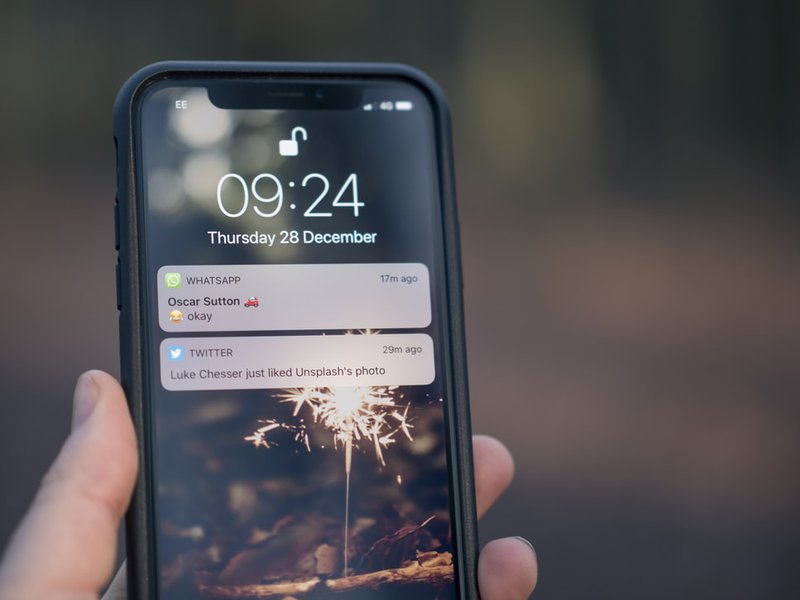
The wide OS support for push notifications also means it can be tricky to design push notifications for each of these platforms.
In this article, we are going to cover what push notifications are and how to design them. You will receive some valuable insight that will help you understand the design of a push notification by “dissecting its anatomy”.
So if you are a product owner and/or a designer trying to craft the perfect push notification to reel your readers in, then you’ve come to the right place.
Table Of Contents
- What is a Push Notification?
- Anatomy of Push Notifications
- Web Push Notifications
- Mobile Push Notifications
- Advantages & Disadvantages of Push Notifications
- Tips For Making The Most Of Push Notifications
- Push Notifications Tip #1: Keep it Short & Direct
- Push Notifications Tip #2: Use The Right Tool
- Push Notifications Tip #3: Figure Out The Perfect Amount Of Notifications To Send
- Final Thoughts
What is a Push Notification?
Push notifications are short, clickable messages that let businesses interact with their customers on mobile and desktop devices. They are commonly used to provide the most up-to-date information, special offers, and promotions, as well as breaking news and live event updates.
Push notifications are permission-based and can be issued by an app or a website. The subscriber receives push notifications on their device once they have registered to the alerts, allowing them to remain up to speed with the latest information.
Even though app push notifications have been available for over a decade, different types of push notifications including web and Facebook Messenger alerts are still relatively young, despite that they have been greatly successful. They are commonly used in the marketing stack to make sure no aspect of audience engagement goes unnoticed.
Anatomy of Push Notifications
Web Push Notifications
Web push notifications appear different to users based on the operating system and the browser they are using. Here’s a breakdown of how push notifications look like in each of them.
Mac-Chrome (Catalina)

a. Browser Icon: Chrome icon. This can’t be changed.
b. Title: Restricted to 20-40 characters.
c. Domain: Website user is subscribed to. Can’t be changed.
d. Content: Restricted to 20-80 characters.
e. Icon: 192x192 or larger. PNG, JPG, GIF (not animated).
Character limitations vary based on whether or not an icon is present and which characters are utilized. Two action buttons are also supported in Chrome for macOS.
Mac-Firefox (Catalina)

a. Browser Icon: Firefox icon. This can’t be changed.
b. Title: Restricted to 60-80 characters.
c. Domain: Website user is subscribed to. Can’t be changed.
d. Content: Restricted to 20-80 characters.
e. Icon: 192x192 or larger. PNG, JPG, GIF (not animated).
Mac-Safari (Catalina)

a. Icon: This is set once and can’t be changed per individual message. Must be 256x256. PNG, JPG, GIF (not animated).
b. Title: Restricted to 40 characters.
c. Content: Restricted to 90 characters.
It's worth noting that Safari lacks a browser icon. It also doesn't show the domain.
Mac-Chrome (Big Sur)
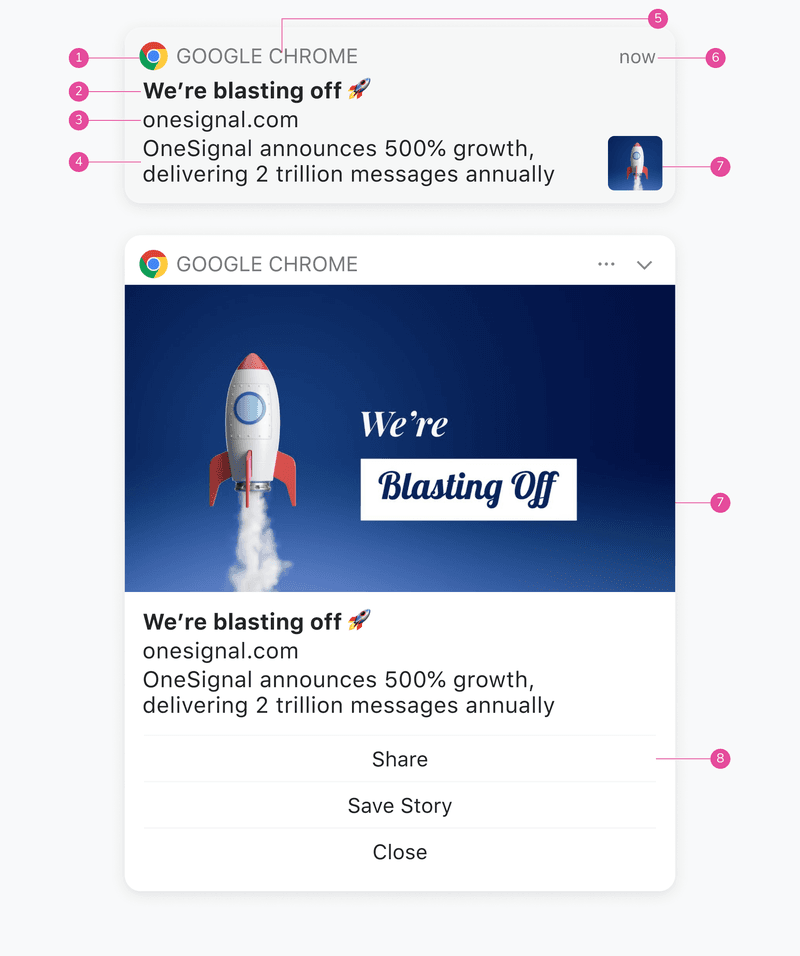
a. Browser Icon: Chrome icon. This can’t be changed.
b. Title: Restricted to 60-80 characters.
c. Domain: Website user is subscribed to. Can’t be changed.
d. Content: Restricted to 120-150 characters.
e. Browser: Can’t be changed.
f. Time Stamp: When the message was received.
g. Icon: 192x192 or larger. PNG, JPG, GIF (not animated). Enlarges when expanded.
h. Action Buttons: Supports up to 2 buttons.
Character limitations vary based on whether or not an icon is present and which characters are utilized. The primary differences between macOS Big Sur and previous versions are that messages may be enlarged with a bigger icon, and the browser icon is smaller, allowing for more content.
Mac-Firefox (Big Sur)
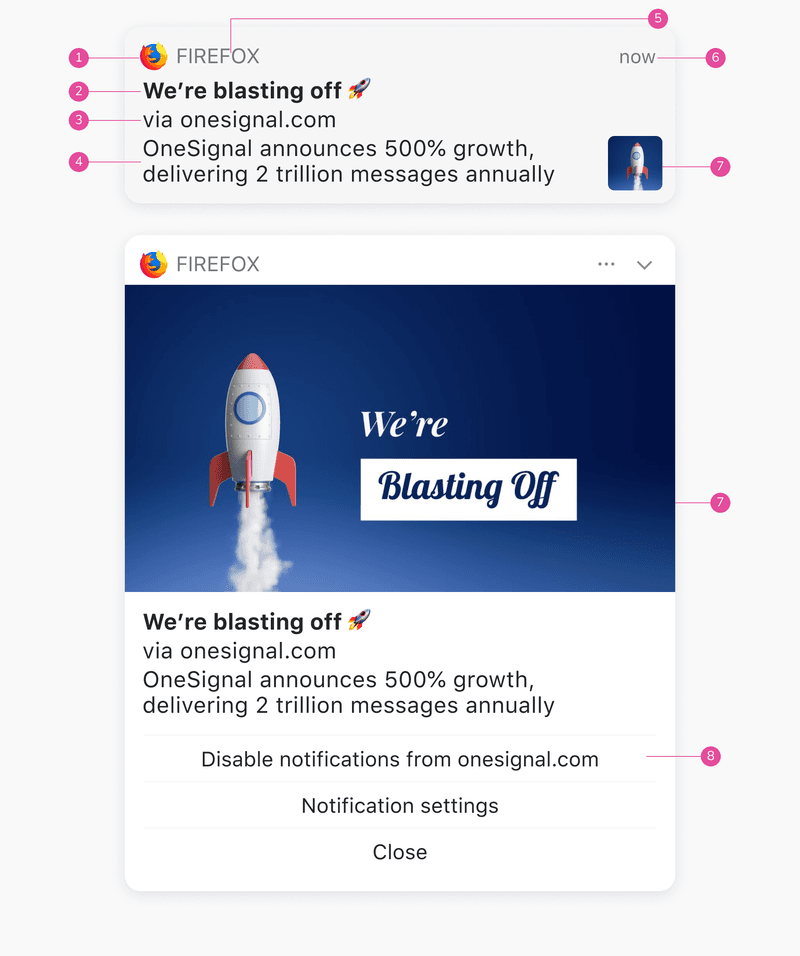
Browser Icon: Firefox icon. This can’t be changed.
Title: Restricted to 60-80 characters.
Domain: Website user is subscribed to. Can’t be changed.
Content: Restricted to 120-150 characters.
Browser: Can’t be changed.
Time Stamp: When the message was received.
Icon: 192x192 or larger. PNG, JPG, GIF (not animated). Enlarges when expanded.
Action Buttons: These cannot be customized for Firefox.
Character limitations vary based on whether or not an icon is present and which characters are utilized. The primary differences between macOS Big Sur and previous versions are that messages may be enlarged with a bigger icon, and the browser icon is smaller, allowing for more content.
Mac-Safari (Big Sur)
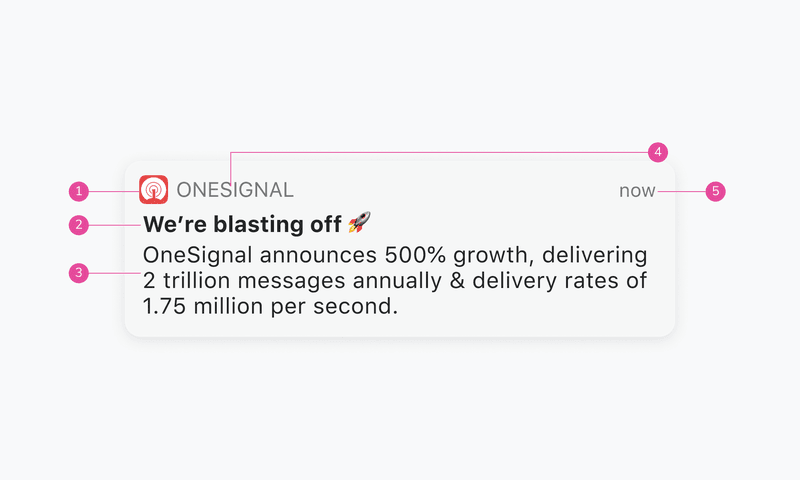
a. Icon: This is set once and can’t be changed per individual message. Must be 256x256. PNG, JPG, GIF (not animated).
b. Title: Restricted to 60-80 characters.
c. Content: Restricted to 120-150 characters.
d. Website Name: Can't be changed.
e. Time Stamp: When the message was received.
Windows-Chrome
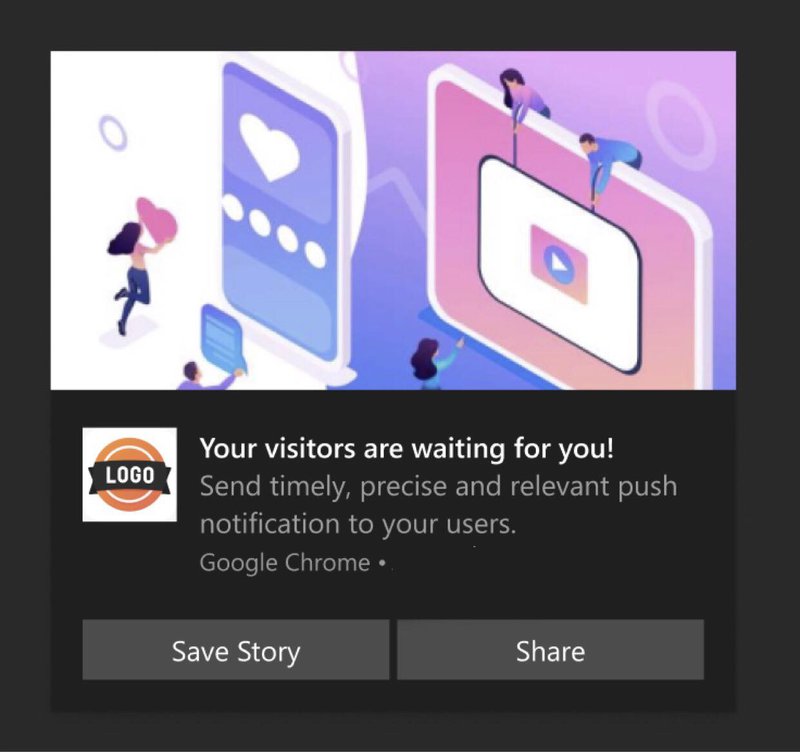
a. Icon: Logo, this can be changed. Needs to be square. Preferable 192*192 or large. Format supported JPEG, PNG, or GIF(not animated).
b. Title: Restricted to 60 characters.
c. Domain: Website user is subscribed, this can’t be changed.
d. Content: Restricted to 120 characters.
e. Browser Name: Chrome, can’t be changed.
f. Image: Needs to be a 2:1 ratio. Preferable 360*180. Format supported - JPEG, PNG, or GIF(not animated).
g. Action Buttons: Supports 2 action buttons.
Windows-Firefox
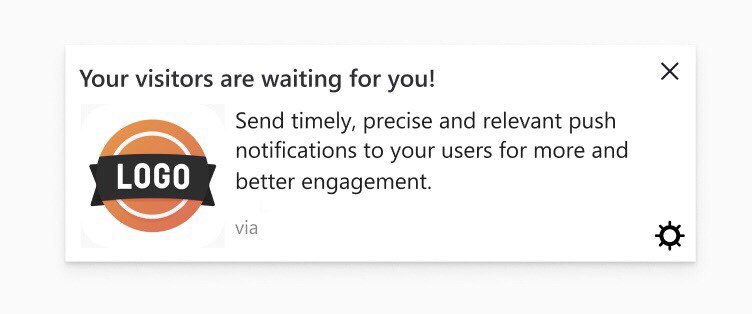
a. Icon: Logo, this can be changed. Needs to be square. Preferable 192*192 or large. Format supported JPEG, PNG, or GIF(not animated).
b. Title: Restricted to 40 characters.
c. Domain: Website user is subscribed, this can’t be changed.
d. Content: Restricted to 140–190 characters.
e. Settings: Can’t be changed or replaced.
Windows-Edge
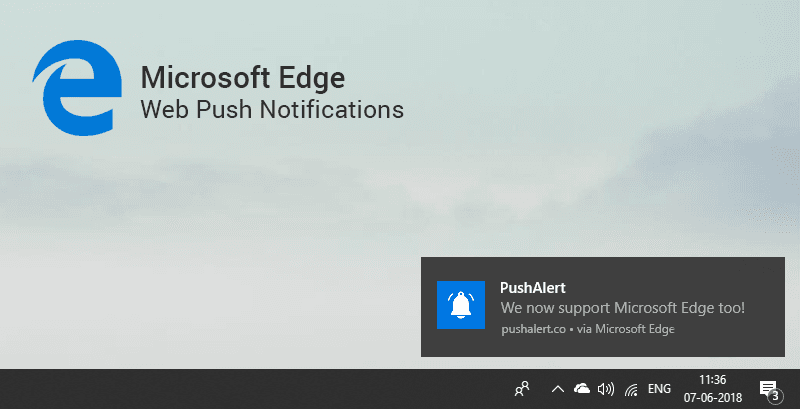
a. Title: Restricted to 40 characters.
b. Icon: 192x192 or larger. PNG, JPG, GIF (not animated).
c. Browser: Can't be changed.
d. Content: Restricted to 140-190 characters.
e. Domain: Website user is subscribed to. Can’t be changed.
Android-Chrome
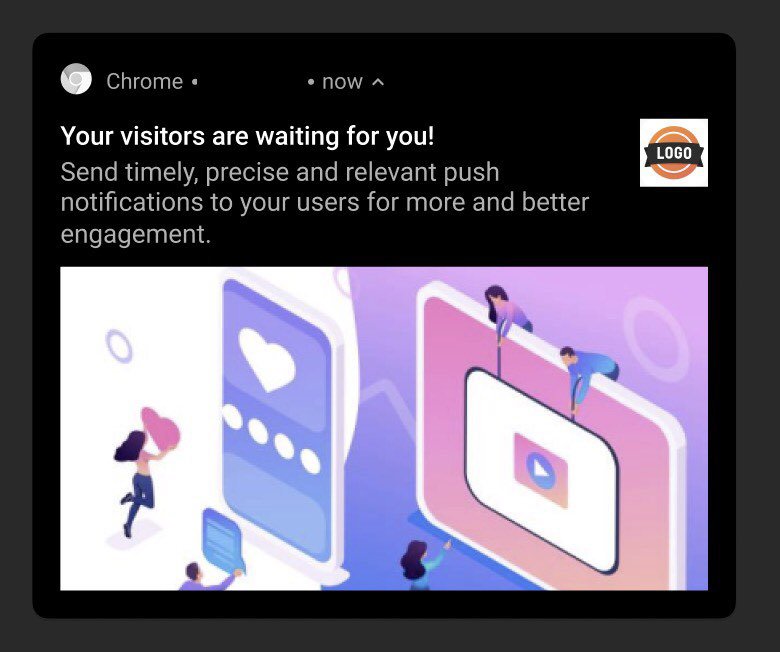
a. Browser Icon: Chrome, must be white with a transparent background. This can’t be changed. Needs to be square. Preferable 72*72 or large. Format supported PNG.
b. Logo Icon: Logo, this can be changed. Needs to be square. Preferable 192*192 or large. Format supported JPEG, PNG, or GIF(not animated).
c. Title: Restricted to 50 characters.
d. Domain: Website user is subscribed, this can’t be changed.
e. Content: Restricted to 150 characters.
f. Large Image: This is open to exploring. You can put the image as per the context of the notification. Needs to be a 2:1 aspect ratio. Preferable 1024*512. Format supported PNG, JPG, GIF (not animated).
g. Time Stamp: When the message was received.
Mobile Push Notifications
Compared to web push notifications, mobile push notifications are less diverse in appearance. Here’s how push notifications look like on two major mobile platforms - Android and iOS.
Native-Android

a. Small Icon: Logo, must be white with a transparent background. This can be changed. Needs to be square. Preferable 24*24–96*96 to fit all device sizes. Format supported - PNG.
b. Logo Icon: Logo, this can be changed. Needs to be square. Preferable 192*192 or large. Format supported JPEG, PNG, or GIF(not animated).
c. Title: Restricted to 50 characters.
d. App Name: This can’t be changed.
e. Content: Restricted to 150 characters.
f. Large Image: This is open to exploring. You can put the image as per the context of the notification. Needs to be a 2:1 aspect ratio. Preferable 1440*720. Format supported - PNG, JPG, GIF (not animated).
g. Action Buttons: Supports up to 3 actionable buttons.
h. Time Stamp: When the message is received.
Native-iOS
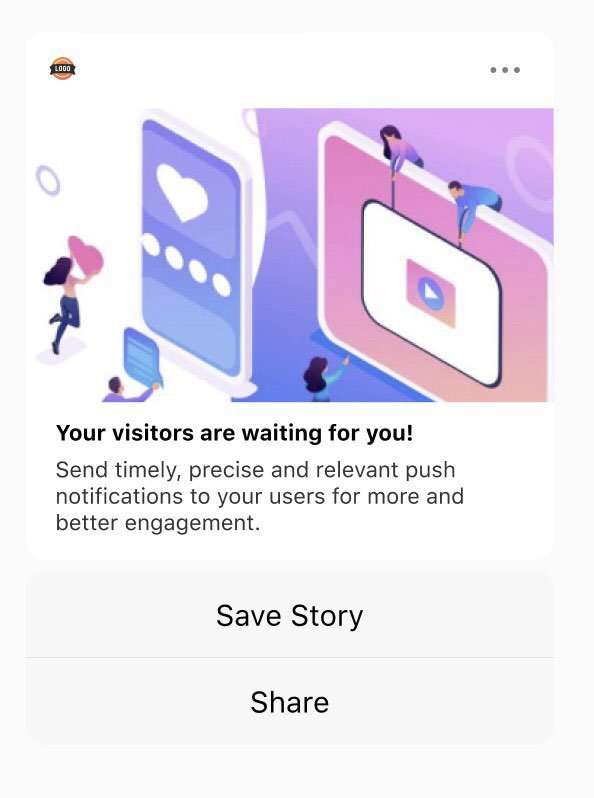
a. App Icon: Logo, this can’t be changed. Needs to be square. IOS uses the app’s default icon.
b. Title: Restricted to 25-50 characters.
c. App Name: This can’t be changed.
d. Content: Restricted to 150 characters.
e. Large Image: This is open to exploring. You can put the image as per the context of the notification. Needs to be a 1:1 aspect ratio. Preferable 1024*1024. Format supported - PNG, JPG, GIF, MP4, MP3, WAV.
f. Action Buttons: Supports up to 4 actionable buttons.
g. Options: The 3 dot option can’t be changed.
A subtitle is also supported on iOS. Note that, unlike Android, iOS does not presently allow web push.
Advantages & Disadvantages of Push Notifications
Push notifications offer a ton of advantages that enable you to engage more viewers. Even still, they may prove to be counter-productive and reduce engagements. Here are some of the pros and cons of Push notifications.
Pros
- Higher Visibility - Push notifications are customized alerts that appear in the corner of a user's browser window, making them extremely visible.
- Higher Conversion Rates - Push notifications have a 7X higher CTR than emails due to their high exposure.
- Optimized - Push notifications and their opt-in options may be tailored to fit the style and theme of a website. They are sent immediately and can also be scheduled for delivery at a later time.
- Reliable Revenue Source - Push notifications not only increase website traffic but also increase ad click-through rates. More and more media businesses are turning to this new stable revenue source, which allows you to monetize your 100% owned audience (subscribers).
Cons
- Interruptive & Annoying - Push notifications are sent in the same way as a pop-up ad, which makes them annoying. While this may work for a company that has clearly established when it will send alerts, it does not always provide a pleasant user experience.
- May become Spam - According to recent research, users receive about 80 alerts each day on average, which is staggering. Imagine your phone blowing up, only to realize you’ve received a dozen notifications about a topic you have no interest in. Annoying, right? Push notifications, which are typically one of the best methods to keep your loyal consumers engaged, must be used responsibly by businesses.
Tips For Making The Most Of Push Notifications
Since you’ve come this far, we can assume that you’ve gained a rudimentary understanding of what a push notification is and how to design one. Now before you get started crafting the perfect push notification, here are some tips to help you along.
Push Notifications Tip #1: Keep it Short & Direct
Making a push notification that truly signifies something is an art. You'll want to utilize a brief, direct message that offers people something to interact with. Good push notifications should do the following:
- Convey an interesting message to the user in a concise way.
- Allow the user to learn more while keeping in mind that many people will never look past the initial message.
- Remind the user of the app from which the message originated (for customer loyalty and branding).
Push notifications should never be longer than the available screen space. Users can receive notifications on their phones (in various places), wearable devices (which take up less space), or desktop computers (larger space). You should design and compose the notification's text using the shortest space possible.
Push Notifications Tip #2: Use The Right Tool
Picking the right tools to craft your push notification campaigns is a crucial step. It can help you optimize the performance of your campaigns easily and get maximum conversions.
When it comes to push notification tools designed for publishers, Monsy is a no-brainer. It allows you to easily capture your audience, and effectively market to them to grow your revenue across all platforms.
With Monsy, you’ll be able to earn more with Push Notifications, which take up little space on your website yet provide immediate revenue and compliment other placements.
You can boost your revenue with a simple straightforward banner that floats on either side of the page. This placement works on both mobile and desktop, allowing publishers to make more money.
Monsy works for all tiers and devices. It has the best results on mobile with the highest CTR and also is the top-performing ad for all GEO. Monsy truly is the one-stop solution to all your publishing needs.
Push Notifications Tip #3: Figure Out The Perfect Amount Of Notifications To Send
An excessive number of alerts may be a dealbreaker for your users. However, if you send out too few alerts, the user may forget about your app or website. You'll need the perfect blend.
The best notifications are those that are welcome by the subscribers - such as, a reminder or breaking news.
Allowing consumers to personalize their push notification settings is an important aspect of the design. Users are less likely to be irritated by the outcome if they can control when and how many messages they receive.
Final Thoughts
Push notifications are one of the finest ways to engage your audience and increase your conversion rates. Hopefully, you now have an understanding of the inner workings of a push notification and how to craft the perfect one for your business and viewers.
However, it won’t matter how perfect your notification is if it’s sent out at the wrong time.
This is the final tip we have for you - time your notification right. If your notifications are sent out at a time when your audience isn’t paying attention, it’ll most likely be ignored. To avoid this issue, use Monsy to optimize your push notifications and grow your revenue by 85% with our top-performing ad formats.
Get started with Monsy today!
Welcome. Bienvenue. Benvenuta. Herzlich willkommen.
People love to feel welcome regardless of language. A pleasant greeting goes a long way, whether you're entering the house of a family member or the office of a new customer.
When users join your app, the same thing applies. It is critical to introduce yourself to establish the tone for your product and build relationships with your audience. This is where onboarding push notifications prove their worth.
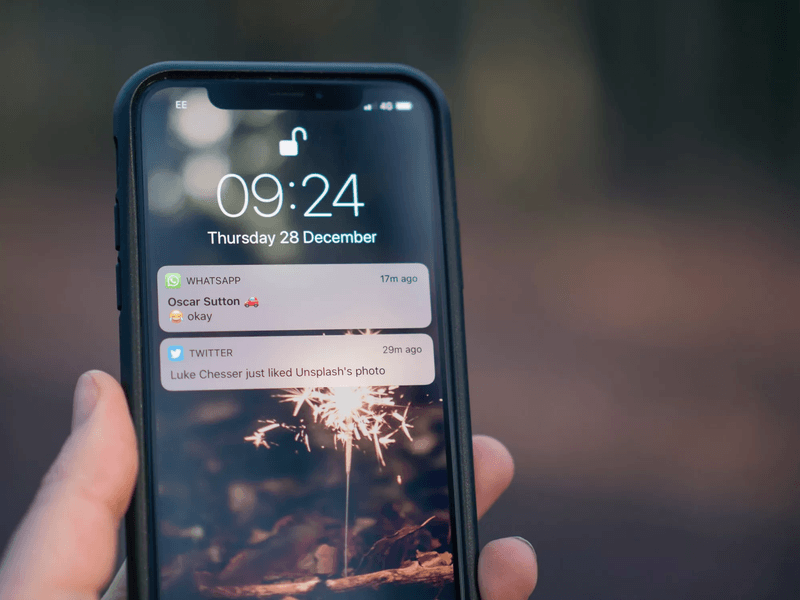
In this article, we’re offering you a collection of the best onboarding push notification templates to use in 2021.
Table of Contents
- Make a good first impression!
- What Is User Onboarding?
- How To Onboard New Users Effectively
- Onboarding Templates for Push Notifications Campaigns
- Best Welcome Notification Templates
- Final Word
Make a good first impression!
You've mastered first impressions in the physical world - you're personable, well-presented, and know your differentiator inside and out. But what happens when the screens are turned on?
Communicating in the digital age is a completely different ballgame. Human behavior and body language are tossed out the door.
So, how can you ensure that your company's brand values are upheld both online and offline?
By assuring that your onboarding approach extends further than the first three screens of app engagement and into your push notification strategy. That's how it's done. If users don't grasp the benefit of your software and how to utilize it, their odds of churning skyrocket.
What Is User Onboarding?
Consider onboarding to be the virtual handshake that adds a reassuring human element to your user experience. The term "onboarding" is derived from the Human Resources (HR) practice of organizational socialization.
Suppose you get a great new job, and on your first workday, you meet with Mary in HR to go over the company's onboarding process. Mary will fill you in with the information, skills, and behaviors needed to operate as an effective team member during your initial onboarding session.
Because of excellent onboarding, you receive a promotion after 6 months, progressively ascend to the top of the organization, and, eventually, achieve your objective of world dominance. Bless you, Mary!
Onboarding in the digital era is similar, just like the above example. Simply replace the new job with a newly downloaded application and Mary from HR with demo screens demonstrating how the software works. And then, voila! You have digital onboarding.
Samuel Hulick, a UX expert, feels that the early stages of digital onboarding are crucial to the total user experience of technology. Effective tech onboarding improves the probability that new users will embrace mobile applications successfully.
App developers should strive to develop onboarding experiences that provide knowledge in a seamless, consumable manner. You can accomplish this by focusing on important moments of success early in the client experience.
How To Onboard New Users Effectively
Campaign for Customer Onboarding
You must nurture the customer once they have subscribed to your push alerts. You must inform users about your business and offerings. This will strengthen the subscriber's bond with your brand.
You can send a sequence of push notifications periodically using a user onboarding campaign. Customers will be more engaged and loyal as a result of this.
Whenever a new customer subscribes/joins, he feels excited. However, user enthusiasm dwindles over time. User onboarding assists in keeping users engaged for an extended period of time.
Notification of Arrival or Welcome Messages
Whenever a new user subscribes, you must send an immediate notification. It serves two purposes:
- Greetings to new users
- Confirming that the user has successfully subscribed
Onboarding Templates for Push Notifications Campaigns
Here is a collection of brilliant onboarding templates based on their use cases for you to get started with your push notification campaigns.
1. For Ecommerce Websites
The majority of eCommerce websites have multiple categories. Users must be informed about your main items and category. During the onboarding process, this is where you can exchange information with your consumer.
Some onboarding push notification templates for e-commerce are:
Day 1: Welcome X (user name) to Y (your site name)! Check our best products and categories.
Day 2: Thanks for joining Y (company name)! As a token of appreciation, we are offering you a 10% discount on any order for today. Grab the deal now!
Day 3: Check our latest collection at (insert link of your products and categories page)
Day 5: Take a look at what our other customers think of our products. Here are the recent reviews! Feel free to let us know how you feel about us.
Day 10: Free shipping for today! We are offering all our products with free delivery only for today. Hurry up and don’t miss out on the opportunity!
2. For SaaS Websites
Customers must be informed about your SaaS products and their features. You can highlight many different features and how to use them in the onboarding push notification series.
Some onboarding push notification templates for SaaS products are:
Day 1: Welcome X (user name)! We are Y (company name). We provide (solutions you offer). We are pleased to have you with us on our journey!
Day 2: Take a look at how to set up your account before diving deep into the features. Here is a short video that will help you out!
Day 5: 5-min read! Here is an informative article on “Best Practices of (a topic that relates to the services you are offering)”.
Day 10: Are you interested to learn more about us? Here are some case studies to give you an idea. Feel free to leave any feedback.
Day 17: Now you can make a demo request to try out (products/services you want to promote)! Feel free to schedule a call or reach us out at (email address).
Day 25: Take a look at some of the reviews that we got from our previous users. Feel free to let us know how you feel about us.
Day 30: We are arranging a virtual session of our upcoming updates and offers. You are cordially invited. Here’s the link to the session! (Insert link)
3. For Travel Websites
Most travel websites include a variety of services such as travel bookings, hotel reservations, car rentals, and more. The onboarding campaign highlights all of your offerings. Share the best vacation spots with new users.
Some onboarding push notification templates for travel websites are:
1. Right After Joining: Welcome to X! Check out the best vacation spots with your friends and family!
2. The Next Day: Use “TRAVEL15” to avail 15% discount on your first booking. Hurry up!
3. After 5 Days of Signing-up: Looking for the top vacation spots? Here are some all-time destinations to spend with your family!
4. After 10-12 Days Of Last Notification: Best Deals!!! Up to 25% off on your bookings for the rest of the month. Grab the deal now!
5. After 20 Days of Last Notification: Last chance to win a trip to Bali! Share your travel moments and experiences with us and get a chance to win a trip to Bali! Just upload your traveling pictures/videos on Facebook/Instagram and tag us.
6. After 1 Month of Signing-Up: Celebrating 1 month of hassle-free traveling! To celebrate your first month with us, we are offering you a 30% discount on all bookings for the next 7 days! Take the vacation you badly wanted.
4. For Job Websites
Job sites are there to provide job-related information. However, they also provide a range of other services such as resume writing and personality development programs. They have two kinds of subscriber base: Job Seeker and Employee.
For the employment website, you will have 2 types of onboarding campaigns. Share pertinent information with them via the onboarding campaign. You can provide resume services, application forms, and testimonials for the job seeker group. The idea is to keep them on your website as long as possible.
Some onboarding push notification templates for job websites are:
1. Right After Joining: Welcome to X (Your Company)! Be updated and get alerts on the job market. Be informed about new job openings!
2. After 2 Days of sending the previous notification: Thanks for joining, X! Now you connect to more than 1000+ leading companies in the United States. Apply now and get hired!
3. After 4 Days of sending the previous notification: Keeping your profile updated can increase your chance of getting hired by at least 60%! Get into the shortlist by updating your profile, NOW!
4. After 6 Days of previous notification: Tired of getting rejected? Here are some interview tips from our experts.
5. After 10 Days of Last Notification: Recruiters spend only 6 seconds reviewing your resume. Is your resume up-to-date? Create a professional and attractive resume now, click here!
6. After 15 Days of Last Notification: We have helped 5000+ candidates to land their dream job! Check out what they have to say about us.
5. For Gaming Website
People nowadays spend hours online. The gaming business has benefited largely as a result. The gaming website may keep customers engaged on its platform by implementing a push notification onboarding campaign.
A gaming website has a wide selection of games. Users could get bored after a while. An onboarding strategy can assist you in retaining the user's attention. A sample onboarding push notification template for gaming websites is shown below:
1. Right After Joining: Welcome to X (Your Company)! Be updated and get alerts on game updates and freebies! Here is your 50 point joining bonus!
2. After 2 Days of sending the previous notification: Get connected to gamers worldwide! Enjoy the realm of gaming.
3. After 4 Days of sending the previous notification: Bonus Points! Log in to the site every day to claim free points every day!
4. After 6 Days of previous notification: Bored of playing the same old games? Try these new and exciting games NOW!
5. After 10 Days of Last Notification: Keep your profile updated and protect your account. We offer the highest security of your e-wallet.
6. After 15 Days of Last Notification: Best Premium Deals! Get 20% off on the yearly membership package. Available for the next 24 hours. Hurry up, grab the deal now!
Best Welcome Notification Templates
The welcoming message is the first notification that a user will get when subscribing to your push notifications. Design a notification that lets new subscribers feel like they did the right thing by subscribing to push notifications.
Here are some of the top welcome notification templates:
Give a Welcome Voucher
A Welcome Voucher is one of the best methods to welcome a new subscriber. Give them a discount on their initial purchase.
Template:
Title: Thanks for subscribing!
Description: This is a small present from us. 10% off your first purchase. Use the code "1234."
Provide Premium Features
Who doesn’t love premium features for free?
Template
Title: Unlocked Features
Description: Exclusive bonus - premium features are now available for your account!
Offer Free Delivery
Any user would love free deliveries. So offering free shipment for a number of purchases can be a good way to keep your user hooked to your business.
Template
Title: Free Delivery
Appreciate you very much for subscribing. Get free shipping on your next ten purchases.
Offer Free Gifts
Give the new subscribers an incentive that will attract them to subscribe. What can attract them more than a free gift?
Template
Title: Claim Your Free Gift!
Description: Your subscription has been successful. To claim the prize, click here.
Final Word
That brings us to the end of our templates for both welcoming notifications and onboarding campaigns that you can use for your business.
A new subscriber is a potential prospect for you. You can effortlessly keep them engaged with your business by implementing an onboarding push notification campaign.
Sign up today and get your onboarding push notification campaigns up and running with Monsy!
Push notifications are short messages that pop up on the users’ mobile phone or desktop to alert them about the factors they opted-in for. Marketers around the world are already putting it to its best use, and if you’re not, you’re falling way behind.
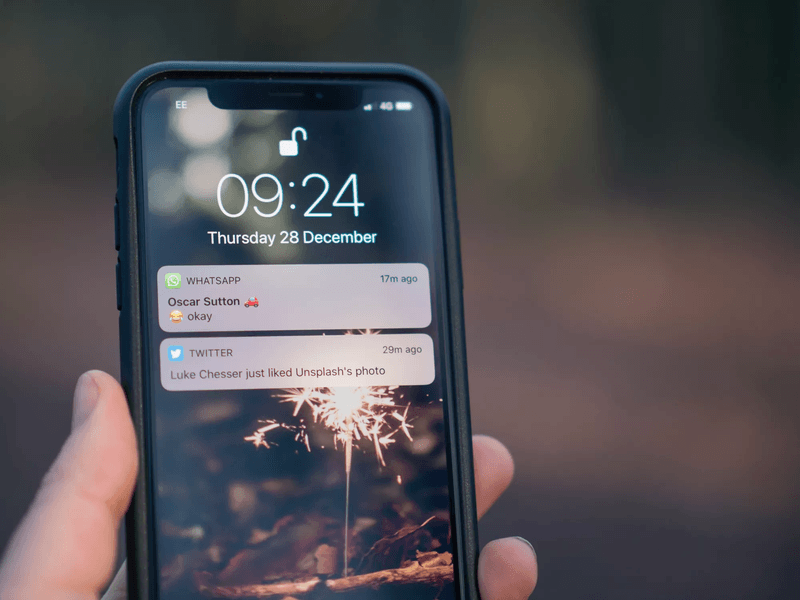
Push notification is a really powerful marketing channel as users are constantly reminded about your product or services through push messages. But you need to send the right type of push messages to make full use of its capabilities.
In this article, we’re going over the types of push notifications that will help you reach your audience effectively and engage them with your marketing communications.
Types Of Push Notifications To Effectively Engage Your Users
1. Geolocation Notifications
When the users enter or leave a location, an app can send them messages based on that. You can create virtual perimeters around some particular areas and send push notifications to the customers in those areas via geolocation push notifications.
Moreover, these types of notifications are extremely useful for sending date match notifications. These can range from finding nearby places to hotels and travel apps. This is a great way to engage with potential customers via a targeted campaign.

Some advantages of geolocation notifications include:
Insights
Using geolocation notifications allows you to access a lot of new data that is used to understand which stores are performing better. It also helps to understand which locations are more lucrative for expanding your business and which customer segment is more approachable.
Efficiency
Sending notifications based on users’ location can make for highly personal and relevant content. This improves the efficiency of push notifications immensely. This also increases the impact your communications create on your buyers immensely.
Engagement
The likelihood of customers engaging with your brand increases by many folds if you provide them with personalized and relevant information at the right time at the right place. This won’t fail drives up your engagement rate.
ROI
You can easily analyze the effectiveness of your campaign as well as understand its response. Geofencing technology allows you to send people offers near your store. This is one of the most effective ways to optimize marketing efforts for better ROI.
2. Promotional Notifications
Promotional push notifications can alert users about time-bound offers like giveaways, flash sales, and more. Hence, users are encouraged to make purchases.
For instance, if we consider the travel app Kayak allows users to set up their notifications themselves for exclusive deals on destinations and dates. This way when these dates or destinations align with the price range that they have set, users receive alerts.
The purpose of promotional notifications is that urges users to take the desired action. These notifications come in handy for a range of industries including fitness, shopping, entertainment, and more.
3. Informative Notifications
Informative push notifications can be found in the form of updates, reminders, FYI messages, alerts, and so on.
Reminder
As the name suggests, reminder notifications are the ones that send out reminders to users so that they don't miss out on the things that they have opted in for. These notifications are sent based on data from external sources and user input.
For example, suppose a user has a meeting at 10:30 am. In that case, an app will accumulate local traffic data to alert the user of the exact time he should leave the house to reach the meeting on time.
Update
Updating the users about the changes in the app and suggesting installing the new version of checking out the much-improved feature are the works of update notifications. These push notifications allow the users to understand that their experience in the app is constantly and continually improving.
Alerts
These are notifications that are used to alert users to something that is directly related to them. For example, in the case of social media apps, alerts notify users about:
- When someone has liked the user's photo.
- When someone has sent the user a message.
- When someone has commented on their post, and more.
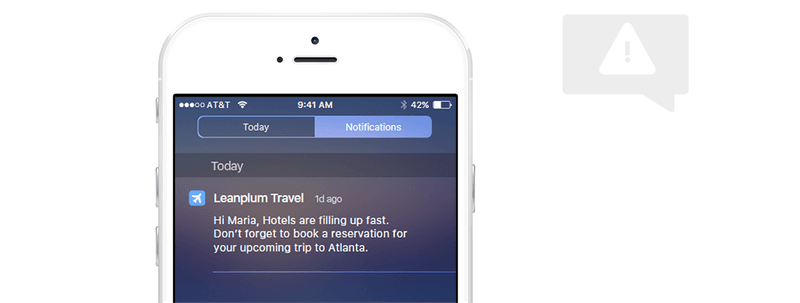
These types of push notifications are perfect for job portals, travel or taxi apps, education apps, fitness apps., social and messaging apps.
For instance, a fitness app named 12-minute athlete lets users set a schedule for their weekly workout and have12-minute the app remind them when it's time to workout.
4. Catch up notifications
Catch-up notifications aim to re-engage and motivate users. For example, when a user reaches a goal in their workout routine, the app can congratulate them for the progress made. This also helps build trust with the user.
Catch-up notifications are perfect for e-commerce apps (marketplaces and online stores), fitness apps, music apps, and others.

5. Recurring Push Notifications
Only a specific time and date are selected to send recurring push notifications to users. Recurring push notifications can be sent monthly or weekly to highlight editorial picks. These push notifications are used for educational or book apps and e-commerce. For example, Musx and Sephora send weekly push notifications to alert their users.
6. Order Push Notifications
You can add value for your users via order push notifications. This is the type of push notification that allows the customers about learning their order's whereabouts.
They consist of information like order status updates, order confirmations, tracking information, and provide digital receipts. These are the best notifications for food delivery, e-commerce, and mobile apps.
7. Rating/Survey Push Notifications
This is an easy way to gather user feedback and improve customer service by analyzing the ratings or surveys. A survey shows that nearly 60% of respondents always or mostly check reviews or ratings before downloading an app.
These push notifications will also help you to improve your app by gathering reviews about what the future versions should look like. This will also increase the number of installs for your app.
8. Trivia Push Notifications
The purpose of trivia push notifications is to be funny and entertaining. These are interesting and relevant messages (filled with love) sent to the users. A great example of how to make trivia push notifications can be found in BuzzFeed news.
A lot of the time we can see news apps sending notifications that have similar or repeated headlines. But we all know the goal of push notifications is to be relevant and unique.
So, if you want to get your point across in a funny and lighthearted way, this is the one for you. It is pretty clear that there are thousands of push notifications that are only trying to promote products or companies. So, ones with a touch of humor would catch more attention.
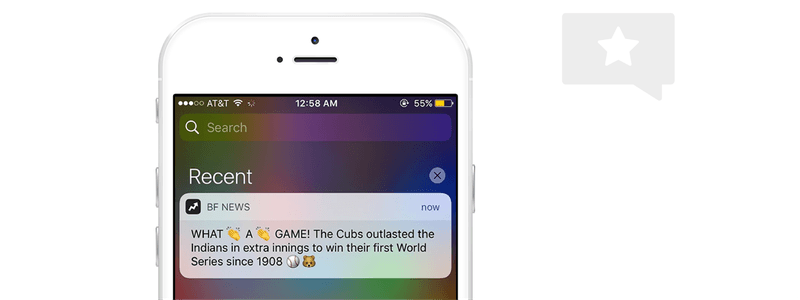
9. Highly Personalized Notifications
If your notification is not about the world ending tomorrow, there are not a lot of alternatives that all of your users could relate to. So, the only that you could get the attention of your users is through personalized push notifications.
Collect enough data about your users' past searches and other pieces of information. This would allow you to tailor your notification to cater to your audience.
Your main goal is to send relevant notifications to your users. for example, Netflix shows their audience the perfect notifications to their users about new episodes of their favorite shows, upcoming movies they might like, and so on.
Sending irrelevant notifications might end up in your users unsubscribing from your notifications altogether.
10. Smart Selling Notifications
This is the type of notification that you send your customers when you don’t want to be too salesy. The audience eventually gets bored because of receiving too many sales messages. But you need to sell your products.
Smart selling notifications are framed in a way that makes them look like you are not trying to sell something, but doing a favor to your audience. This requires you to gather data to send hyper-personalized and timely alerts based on triggers.
But how do you craft smart selling notifications?
The first thing to do is making a list of all the trigger events that would lead someone to purchase your products. Here are some of the reasons:
- Extreme weather conditions: Stay the night at ___ city for the lowest price. Hotel options and links.
- Airport closure or delays: Stay an extra night at ___ hotel for the lowest price with the best discounts.
- Uber reminding users to request rides when the rates are the lowest.
11. Limited Time Sale Notification
Push notifications are the best option when reminding your users about a new offer that you have just launched. And when it is a limited-time offer, you want to inform your users about it as early as possible.
So, what better way to do it than sending a notification that is going to be front and center on their screen?
This way both you and your user get value. You receive value in terms of driving up sales and the user gets value from receiving relevant information. This also ensures that you’re not annoying your users rather doing them a favor by notifying them about the sale so they can be the first to grab it.
12. Inbox Push Notifications
Some apps and websites use an inbox to store their notifications. Such as there is an App Inbox for mobile notifications and a Web Push Inbox for web push notifications.
This feature allows the user to access all of their notifications when they click on the inbox icon of the app. The best part about inbox push notifications is that even if the notifications of your app are disabled on the users’ device, they can still check the inbox to find them. All the notifications are saved in the inbox until the app is opened.
Final Thoughts
Marketers are already using push notifications to engage their customers effectively via push notifications. App notifications are sent on mobile phones as long as the notifications are enabled. And in the case of web push notifications, it is stored in both computers and mobile phones.
These types of push notifications can be also received through wearables. This makes sure that users have access to them whenever they want. Choosing the right type of push notification makes it easier to engage your audience and get them to convert.
Get started with Monsy and see how you can engage your audience effectively using push notifications.

Are you looking for a fresh way to engage your users? Try reaching them with web push notifications. But sending web push notifications in bulk to all your users won’t get you the results you want. You need a clear strategy that suits your product/service and your target audience.
Usually, these notifications are actionable messages that are scheduled, customized, and relevant. Web push notifications offer you a smart way of driving engagement and holding the visitors to convert them to leads.
The road to making visitors opt-in for push notifications is often a bumpy one with no clear guideline.
To help you get through this, we’ve compiled a list of 20 tried and tested web push notification strategies that can boost your conversion rates steadily.
What Is Web Push Notification?
Web push notifications are messages or alerts sent to the devices of users from a website. These are also known as browser push notifications, as users need to have a browser to receive push notifications.
Web push notifications are quite popular in the e-commerce, media, publishing, and blogging industry. In fact, these sectors combine to make up 40% of all web push notifications senders.
Push notifications boast an average click rate of 10.3%, making them ideal for marketers looking to reach their customers in real-time.
20 Web Push Notification Strategies To Engage Your Audience Effectively
1. Personalize the Opt-in Prompt
Personalized opt-in prompts give the users a clear connotation of the type of notification they will be getting after they are opt-in. Hence, to make them opt-in, customize the opt-in prompt rather than using a standard one for everyone.
Additionally, this is an opportunity to add value to your notifications so that the subscribers don’t unsubscribe soon.
2. Segment Your Audience
Segmenting your audience allows you to target specific audiences and send relevant notifications to them. Web push notification platforms track information that you can use for segmenting audiences.
The segmentation should be done based on the user’s device, geographic location, number of visits to the website, last visit, and so on.
3. Make It Browser or Device Specific
The presentation of the notifications is also important. If your notifications aren’t tailored to each browser and device type, the notification headline or the body might get cut off. This gives off a sloppy look, which is certainly not the impression you want to create.
Personalizing the audience based on their device and the type of browser they are using will allow you to adapt your notification strategy accordingly.
4. Integrate Action Button
Your click-through rates say a lot about the success of your web push notifications. If the subscribers are not clicking the notifications, you will have a hard time reaching the marketing goal.
Incorporating the action button will allow you to boost your click-through rates. Moreover, calls to action are an integral part of any marketing communications. It gives your subscriber an idea about the content along with making the path easy to do it.
Ecommerce stores can include, “Add to cart,” “Check out now”. Blog owners can add “Click here to know more”. CTAs like this can do wonders regarding enhancing your click-through rates.
5. Consider The Timezone
Imagine receiving a push notification at 3 in the morning. Sounds annoying right? This is why your push notifications require optimization according to the user timezone.
Optimizing web push notifications according to the user timezone will allow you to send them at the perfect time, ensuring a great user experience.
6. Make Use Of Triggered Campaigns
Usually, web push notification campaigns are of two types: manual and triggered. Setting up a manual campaign is a cakewalk - Organize the campaign, pick the audience, and schedule it.
Triggered campaigns are different. They are a result of a user’s action on your website. Therefore, after setting up a campaign, you have to decide the right trigger to make it relevant.
The actions can include exiting the cart, visiting a specific page, or opting in for web push notifications. Trigger campaigns are immensely relevant, hassle-free, as well as efficient.
7. Personalize The Notification Body
Notifications with dynamic elements, for example, the first name of the user are extremely efficient. You can include fallback texts as well if the custom attribute no longer exists for a specific user.
8. Conduct A/B testing
A/B tests are the most efficient marketing tactic to enhance campaign efficacy. It helps you to decipher what improvements you need to make to get more click-through rates.
A/B testing is an infallible way to enhance conversion rates and improve click-through rates. Instead of guessing, experiment with headlines, body texts, action buttons, and more.
However, don’t change the whole notification while conducting A/B tests. Slightly tweak it by using a different text font, or changing the headline, and so on.
This will help you to understand what is working best for your subscribers. Changing the elements drastically for each version will making it quite hard for you to grasp which is actually effective.
9. Use Custom Icons
Integrating visual elements will make your notifications stand out. The best practice is to use customized icons. Along with your logo, an additional image will let the subscriber differentiate multiple campaigns.
For example, using a bulb icon for sending tips through notifications can be a simple differentiating tactic.
10. Push Welcome Messages
Welcome messages are a great way to add a personal touch to the communication. You can automate welcome messages to trigger right after a visitor subscribes to your web push notifications.
It lets you introduce your brand to potential customers. Moreover, you can educate the subscriber about the navigation of the platform along with highlighting special features. Welcome messages are an ideal way to guide new customers to have a seamless experience.
11. Track the On-Site Activities of a User
Before the opt-in appears, your visitors need to understand the benefits they will be getting from your platform. You can use trigger-based notifications to make sure you can push the opt-in prompt after the visitor has realized the benefits and is more likely to subscribe.
For example, e-commerce website owners can set the opt-in to trigger after a visitor browser several times or after viewing an item. Activities like this portray that the service you are offering is beneficial to the visitor.
If your website is related to a blog then you can customize the opt-in to appear after a visitor has read your posts. This makes sure that a visitor decides to opt-in only after going through your content.
Therefore, automating opt-ins to appear after a visitor spends a certain amount of time on the website or mobile app is an efficient method to add value to your notifications.
12. Identify The Best Pages to Push Opt-ins
Analyze a buyer’s or visitor’s journey to identify which pages are performing best to increase conversion rates. You can adjust your opt-in strategy in a way that best fits the user’s experience on these pages.
Usually, customers of e-commerce websites track their shipments via mail or mobile app. This is the opportunity to take their permission for receiving web push notifications for knowing updates regarding shipments and other offers.
You can strategically set opt-ins to trigger on the checkout page. Instead of asking permission for push notifications, be a little diplomatic. Tell them that the push alerts would let them track their orders, get product recommendations, inform them about relevant information and promotional activities.
Moreover, you can ask permission for sending notifications regarding stock updates. This tactic will contribute to increasing the number of your customers.
13. Use Brief Permission Texts
Your opt-in messages notify the visitors or users why they should sign in to your notifications. Therefore, the permission texts should carry a brief image of the benefits they will be getting after they subscribe to your notifications.
However, the permission texts should differ according to the audience. You need to do customer segmentation to implement this. This would let you frame your texts catering to the interests of specific audience groups.
Convey the benefits of receiving web push notifications from you. Let the audience know that by subscribing to your opt-in messages, they can keep themselves updated about flash sales, discounts, and special offers.
14. Inform Users About Unsubscribing
To make people open to receiving alerts, you need to build a relationship of trust with them. Let them know that you are concerned for their privacy as well. Don’t forget to include that they can easily unsubscribe from the service.
15. Add Catchy Headlines
The headlines of your notification should seem convincing enough to grab visitor’s attention. Be creative with the tone. Add some humor or a powerful message. The headline should be appealing to your target audience.
16. Combine Web Push Notifications With Other Channels
Web push notifications are being widely used by digital marketers. The side effect of it is that visitors are being pickier on which notifications to receive. Consequently, the click-through rates are decreasing.
But with the right approach, you can steadily increase your opt-in rate. To promote your notifications, you can utilize other channels like social media, emails, newsletters, and more.
You can inform users about the perks of receiving push notifications from your website by creating posts on social media or mentioning them in your newsletters.
17. Place CTA Buttons on Your Home Page
The majority of traffic on any website is pulled to the homepage. Therefore, adding a call to action button on that page makes it easier to have people opt-in for your push notifications.
Set the CTA button on the top of the page to grab the visitor's attention. You can choose to A/B test the positioning and color of the CTA button to figure out which will work better.
Note that, since the CTA button will be attention-grabbing, it is important that the rest of the components are plain on that page. Such as the header and the footer. Otherwise, the page might look messy or cramped.
18. Utilize Exit-Intent
Bringing visitors to your website is not the only task that you should be focusing on. The main goal is to make them subscribe to your notifications along with converting them to customers.
Most of the time, visitors tend to leave the site without performing these activities. An exit-intent pop-up can be a savior in this regard. When a visitor is about to leave the site, you can use a pop-up to make them think twice.
These pop-ups can notify you about discounts, sales, offers, promo codes, vouchers, and more.
This technique will encourage visitors to sign-up for your web push notifications. Besides, it increases online visibility as well as contributing to the promotions of your products.
19. Offer an Incentive
Incentives are an ethical and efficient way of luring in new customers. This not only is a way to convince people to subscribe but also a way to drive up your engagement figures.
The incentives can be ebooks, audiobooks, podcasts, exclusive articles, webinar invitations, discounts, and much more. Incentives should be provided to existing customers as well as potential customers. Because this is also an efficient way to keep the existing customers hooked.
20. Track Conversion Rates
Tracking conversion from web push notification campaigns is an absolute necessity. Ecommerce brands can track sales from a web push campaign.
Besides, setting up custom events as conversions is also helpful to track how a web push notification performs.
Increased CTR does not matter if the conversion rate is low. This means, there is a lot of room for improvement in your marketing activity.
Track conversion rates and make changes according to requirements to make the best of your marketing efforts.
Wrapping It Up
Your approach to crafting web push notification strategies will depend on your brand and marketing goals. The list we’ve compiled for you includes 20 web push notification strategies that are fairly effective for all types of companies and brands.
To implement these strategies, you need to first understand your users, and then pick the strategies that work best for them. Monsy helps you capture your audience easily and grow your revenue by reaching them on multiple platforms.
Sign up today and get your web push notifications strategy up and running in no time!
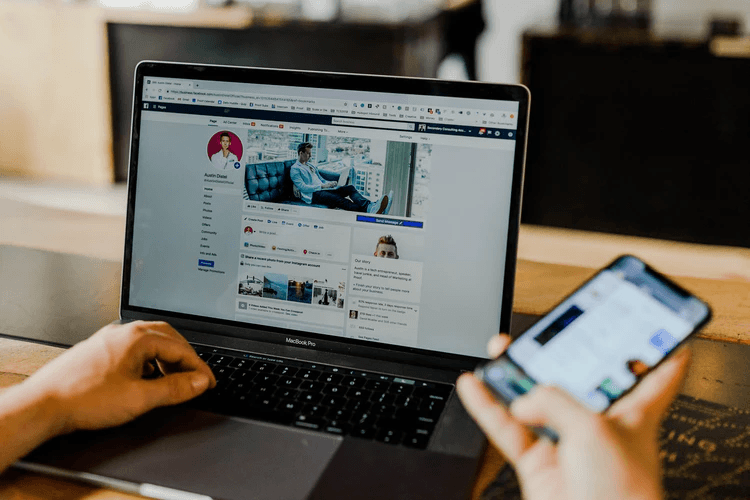
Successful entrepreneurs know the value of passive income. It not only serves as a safety net but also as a tool that can help an existing business grow further. This does not mean starting another business altogether, but finding ways that complement and help the business one already has, be more successful by offering more value to customers.
One of the most relevant examples of passive income in the status quo is Affiliate Marketing. According to Statista, businesses in the USA will spend approximately $8.2bn in Affiliate Marketing by 2022.
In this guide, you will learn what Affiliate Marketing is and how you can get started in the exciting world of affiliate marketing.
What is Affiliate Marketing?
Affiliate Marketing is a marketing model where an affiliate partner is paid a commission for promoting a product or service made by another company. In this model, companies reward affiliate marketers with a payout for providing a specific desired result.
Generally, these results include sales made by affiliate marketers through promotion. These sales are tracked through affiliate links from one website to another.
However, some affiliate programs may offer affiliates rewards or commissions for clicks to a website, free-trial users, leads, or downloads for an app.
Most affiliate programs are free to join so there won’t be any high start-up costs if any. If affiliate your marketing is done right, it can go from being a side hustle to a sustainable online income source.
How does Affiliate Marketing work?
Affiliate Marketing works by outsourcing product marketing responsibilities to capable individuals & parties (affiliates).
This helps leverage the abilities of affiliate marketers for an efficient marketing strategy & provides them with a share of profits at the same time.
Three different parties are involved in affiliate marketing:
- The Sellers (Businesses who recruit Affiliate Marketers)
- The Affiliate Marketers or Affiliates
- The Consumer
The Sellers
Sellers are retailers, merchants, vendors, or product creators/service providers. When referring to sellers, one can mean both entrepreneurs or big corporations.
The Sellers can also be referred to as the ‘Brand’. They do not need to be actively involved in the marketing process, but they may still advertise and earn profit through the revenue sharing in Affiliate Marketing.
The Affiliate Marketers or Affiliates
The Affiliate Marketer markets the seller’s products or services in an innovating and appealing way to potential buyers.
Their job is to convince customers to buy the product or service they are promoting by highlighting the value & benefits of the product/service. Affiliates can either be an individual or a big company.
Affiliates usually have a very specific audience with distinct interests to which they cater. This creates a niche that helps the affiliate promote to customers who are more likely to buy the product or service.
For example, a YouTuber who reviews gaming peripherals is the ideal choice for a company like Razer or HyperX to make an affiliate. This is because that individual caters to the interests of the target audience of the aforementioned companies.
The Consumer
Consumers are the most important stakeholders when it comes to Affiliate Marketing.
The Affiliate Marketing Model centers around consumers and their purchases. Affiliate Marketers promote products & services to consumers through videos, blogs, social media & websites.
Affiliates may choose to be transparent with consumers by disclosing that they are a part of a profit-sharing process for the product or service they are promoting. Affiliates can also choose to withhold this information and consumers may be left in the dark about the affiliate marketing system behind their purchase.
Nonetheless, consumers are not going to pay more for the product in most cases.
This is because the Affiliate Marketers and Sellers share in the profits included in the retail price. The consumer & their purchases will remain unaffected by the affiliate marketing infrastructure.
But it’s still a good practice for affiliate marketers to disclose the information about any brand affiliation so that customers can differentiate word-of-mouth from marketing content.
Why Should You Be An Affiliate Marketer?
If you are still not unconvinced about affiliate marketing, here are a few reasons to join this field.
Convenience
Affiliate Marketing grants you freedom and flexibility. You can choose the people you want to work with, the products you want to review and promote, your working hours & setting your own goals.
You are also free of company restrictions & regulations. This flexibility grants you the ability to diversify your portfolio. You essentially become your own boss.
A Steady Stream Of Income
With affiliate marketing, you only need to spend an initial amount of time on a project. After you’ve done that, you will be making a return on that investment continuously every time a consumer chooses to purchase a product through your referrals.
Affiliate Marketing can be a great option for those who hate the traditional nine-to-five job where you get paid for the 8 hours of work you do five days a week.
Being an Affiliate will help you have a steady flow of income while you sleep, or even when you’re taking your dog out for a walk.
No Start-Up Costs
The barriers of entry into Affiliate Marketing are nearly non-existent. You can join an Affiliate Marketing program for free.
You do not need to worry about a steady cash flow to finance the products you promote either. The expenses when it comes to affiliate marketing are directly linked to your skills.
For example, if you promote products to your audience on YouTube, you will need to make videos. If you need to hire a video editor, then the money you pay your editor will be a part of your business costs for Affiliate Marketing. However, if you edit your videos yourself, then the only business expense is the time you spend recording & editing your videos.
Work From Anywhere
With Affiliate Marketing, you do not need to worry about taking the subway or navigating through annoying traffic to get to the office. Affiliate Marketing allows you to promote products and receive revenue while you are in the comfort of your bed or out on vacation somewhere in Europe.
Performance-based Rewards
Affiliate Marketing rewards you based on how much time and effort you put into it. If you refine your work and make creative & engaging content, you will make more money as you get better at convincing people to buy the products you promote. You will be rewarded for the extra work you put in.
How do Affiliate Marketers get paid?
The main goal of an Affiliate Marketer is to promote a product to a potential customer.
But how often does an Affiliate Marketer get paid?
In some cases, the consumer does not need to purchase the product for the Affiliate Marketer to generate revenue. There are multiple ways an Affiliate can get paid. These are:
- Pay Per Click
- Pay Per Lead
- Pay Per Sale
Pay Per Click
Here the main objective of the Affiliate Marketer is to direct the consumer to the Seller’s website from the platform where they promote the products. The Affiliate is compensated in direct proportion to the increase in traffic to the Seller’s website.
Pay Per Lead
The main objective of the Affiliate Marketer here is to convert leads. This means that the Affiliate has to persuade the Consumer to visit the Seller’s website and participate in the desired action. This may involve subscribing to a newsletter, downloading software, signing up for a free trial, etc.
Pay Per Sale
This is the payment structure that has been mentioned throughout this article. Here, the Affiliate Marketer has to convince the consumer to purchase a product through their marketing skills.
When the product is purchased, the Seller gives the Affiliate Marketer a percentage of the retail price of the product.
For example, YouTubers often promote a product to their viewers and give them a special code for a discount to incentivize them to try the product out. The code also helps track how many people purchased the product due to being referred by the Affiliate.
How Do You Start Affiliate Marketing?
If you want to get into affiliate marketing, but don’t know where to start, you might want to pay attention to this.
Here’s a short guide on how to get started with affiliate marketing.
You need to decide what type of content you want to create, which platform you will use, and what niche you’ll be catering to.
Choose Your Content
You can approach Affiliate Marketing in a lot of different ways.
- Niche Content Reviews: Some sites focus on specific products & services. These sites review products and/or compare these products with their competitors. To approach Affiliate Marketing through this method, you will need to regularly create content related to the relevant niche to increase website traffic.
- Educational Content: If you are a teacher or educator, you could incorporate affiliate marketing partnership offers into your courses, events & workshops.
- Online Content: You may create content and post them on platforms such as YouTube, Instagram, Facebook, etc. You may also post on blogs and other social media. The objective here is to produce niche content that your audience will enjoy and resonate with. This makes it more likely that your viewers will purchase the product you are promoting and you will earn a commission.
Keep in mind that whichever method you choose, you will need to be authentic and honest with your audience. Try to build a community through transparency, otherwise, you will fail to convert your audience into affiliate sales.
Choose Your Platform
You might be confused about which platform you should start your Affiliate Marketing journey on. It is a reasonable concern since there are so many platforms out there. You should choose the platform you are most comfortable with and understand the best. Doing so will allow you to create high-quality content and earn more commissions.
Each content creator & Affiliate Marketer utilize different platforms based on the type of content they produce, the type of product they review, and the type of audience they cater to.
Choose Your Niche
Choose to make content about subjects you find interesting or a field in which you have an educational background or expertise.
If you find a topic that blends in your passion and knowledge, you will be very successful in Affiliate Marketing. This is because the quality of your content will be reflected by how much passion you have.
This will help you build your audience since they will have a more immersive experience and you will have a higher chance to convert them into affiliate sales.
For example, TaehaTypes is a YouTuber and Twitch Streamer who loves building mechanical keyboards. He films himself constructing keyboards from scratch & makes this seemingly boring task into an enjoyable experience. His videos have a ‘premium’ feel due to their high quality. He has amassed nearly half a million subscribers on YouTube and 200k subscribers on Twitch at the time this article was written.
Final Thoughts
The goal of this article has been to give you a fundamental understanding of affiliate marketing. Applying these fundamentals will help you get started on the right track.
Do not expect to earn millions of dollars overnight just because you joined a free affiliate program. Yes, Affiliate Marketing programs are a viable way for you to add a new income stream without bearing too much risk. But like all good things, this will take time.
Set easy milestones at the beginning of your journey. Focus on making your first affiliate sale. As your business grows, find out what works for you and what does not. This is how you will build a reliable income stream through Affiliate Marketing.
Growing your audience steadily can help you gain more credibility, and land you better affiliate marketing opportunities. Monsy helps you capture your audience easily and reach them on multiple platforms effectively.
Sign up today and start getting the results in no time!
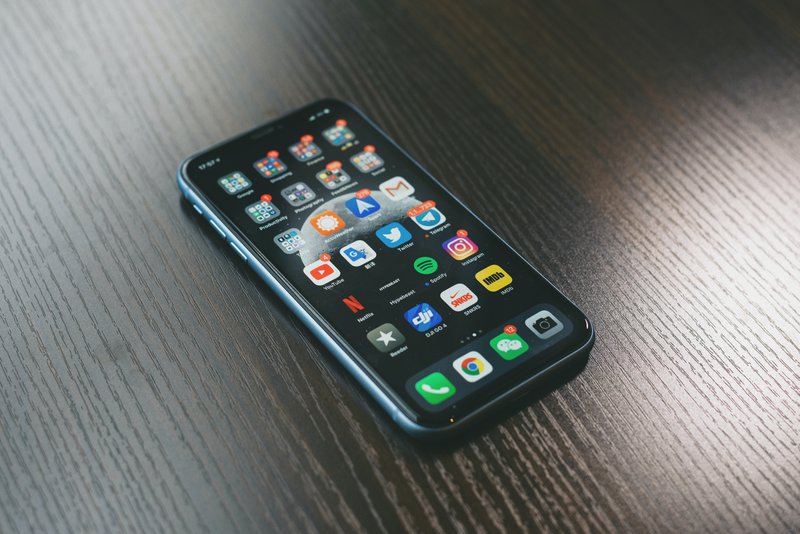
Push notifications are one of the smartest marketing tools for any e-commerce business. Like all other marketing channels, you need to use it the right way to reap its benefits. Using the right templates can help you make sure that you are sending relevant, personalized, and concise push notifications that have a clear call to action.
Studies show that 43% of users disable push notifications for an app after receiving 2 to 5 notifications a week. So you have to get more done with less, and the right template will help you do just that.
In this article, we’ve curated 40 Push notification templates to up your game, and drive actions from your users wherever they are.
What Is A Push Notification?
Push notifications are short messages that are sent to users in real-time and can be used to nudge them towards an action.
Push notifications are extremely effective to drive traffic to apps and websites. But they must be relevant and engaging and need to be timed properly to drive the action you want.
Push notification templates help you get inspired from the tested campaign ideas and saves time and effort on your part. That being said, you also need to choose the template that best suits your use case and make sure it’s consistent with the rest of your marketing communications.
40 Push Notification Templates To Use In Your Next Campaign
1. Welcome offer
Everyone appreciates a warm welcome while visiting a new place. The same goes for a new user of your website or app.
Here’s what to keep in mind while sending a welcome message:
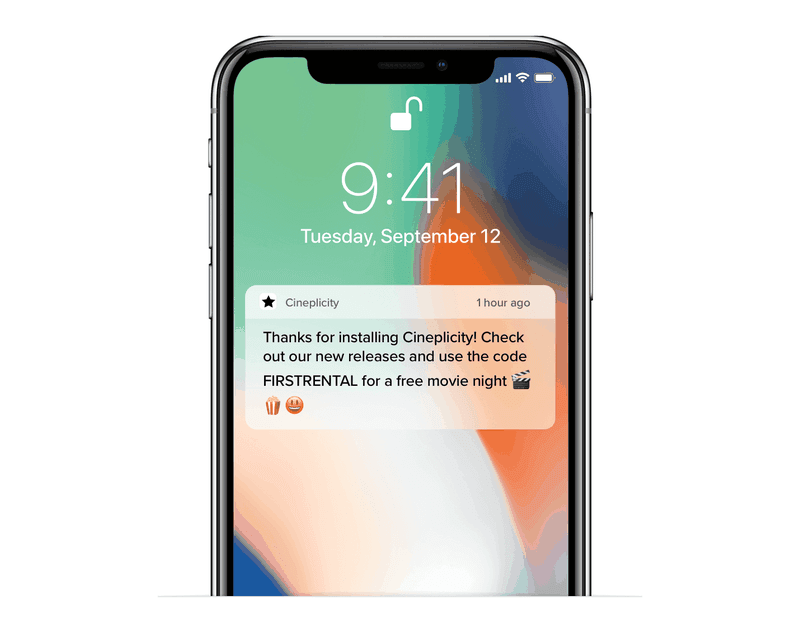
- Lead the user to your product section, where they can browse, and hopefully, make their first purchase.
- Introduce your whole platform to the user while greeting them through a push notification, thus building a bond with them from day one.
2. Signup Campaign
You can send a push notification to the users nudging them to sign up by registering or creating an account. You could add the following push notification templates to convince them:
- Free shipping to users who have completed the registration process.

- Ask them if they would like to save their shipping address and preferred mode of payment for easier checkout in the future.
3. Send A Birthday Offer Or Discount
Who doesn’t love a birthday surprise?
Make your users feel special on their birthdays by offering them special discounts and offers. Say, a push notification providing a 15% discount on the new leather shoes.
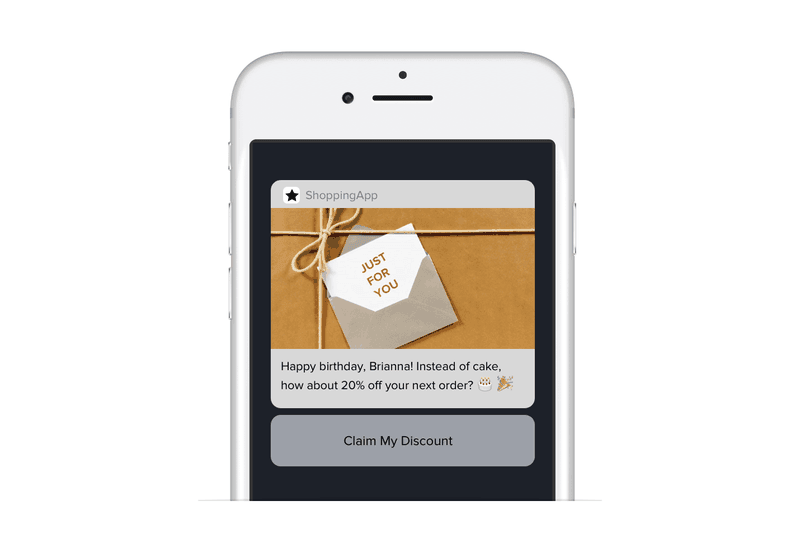
One small reward on their special day will make your brand stand out from the crowd. Who knows? They might even make another purchase from your company within a few days!
4. Recommend Products Based On Their Previous Order History
Suggest products based on their interests through push notifications to the users. You can use the consumers’ previous purchase history to recommend them similar products.
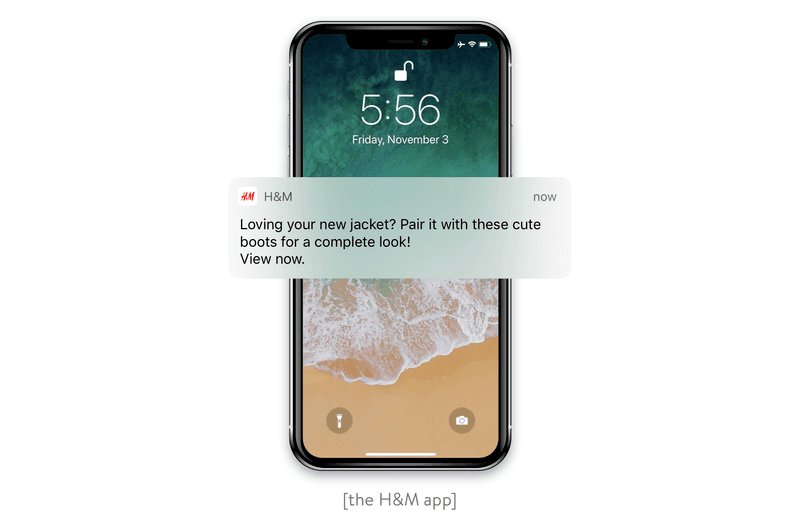
According to Salesforce, 51% of consumers expect companies to anticipate their needs and make relevant suggestions before they make contact.
5. Suggest A Weather Related Notification
Providing real-time updates makes the users feel connected with you. Here’s how you can use a push notification to send real-time updates:
- Send push notifications according to the present weather of the users’ location creates an engaging feeling for sure. Seize this opportunity to promote some of your products as well.
- The template could look like this: “Looks like it might rain this week! Stay dry with our exclusive Auto Open & Close Umbrella.”
6. Event Or Holiday Specific Push Notifications
Celebrate Christmas or Halloween with your consumers and greet them on these occasions - from “little” ones like National Donut Day to major ones like Thanksgiving. A small effort goes a long way to build trust with your customers!
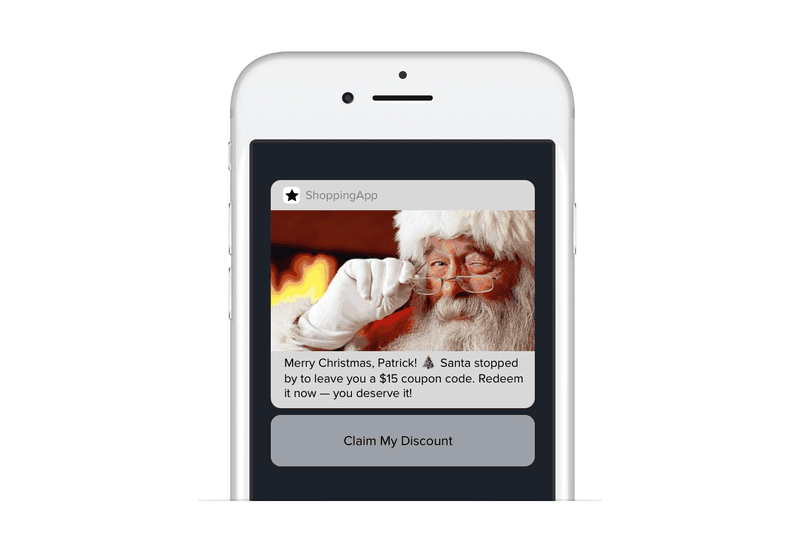
7. Retention Campaign
Bring back disconnected users by reminding them through push notifications. This will eventually help you to increase retention. Lure them out with exciting deals and exclusive offers.
A push notification targeted at retention could look like “Hey, it’s been long since we last saw you. Did you check out our recent offers and special discounts yet?”
Or, offer a flash sale could do the trick.
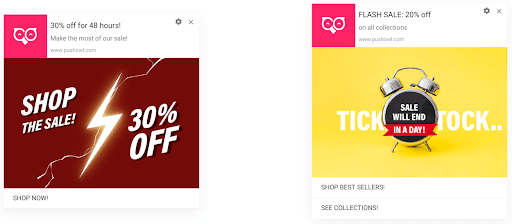
8. Post-purchase incentive
After a user has made a purchase from your brand, don’t just end it there. Send a push notification thanking them for putting their trust in you. That way, the user feels special and looks forward to buying from you again.
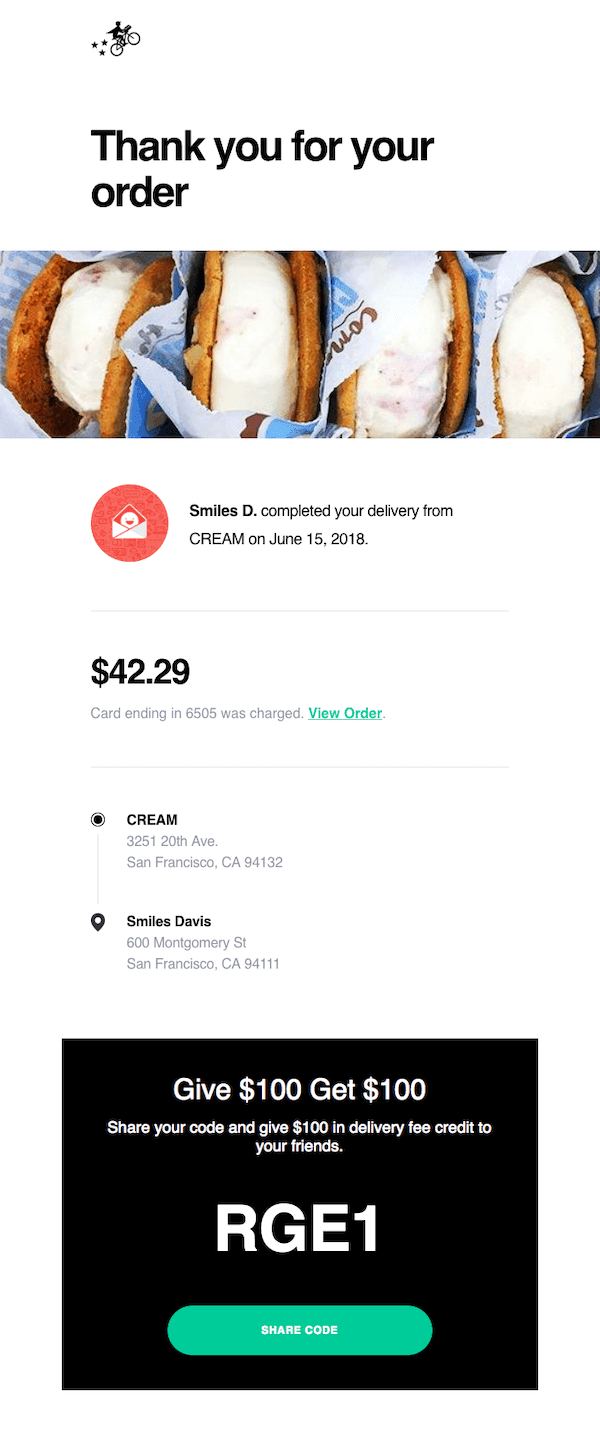
9. Tempt Them To Provide Feedback
Taking feedback from users about their experience with you is a crucial prerequisite for future growth.
- Try to initiate a conversation with the users about whether they’re satisfied with your service by sending a push notification. According to an article of ‘Mmaglobal.com’, it increases the efficacy by 5 to 10 times than it does when people are simply asked to rate the services.
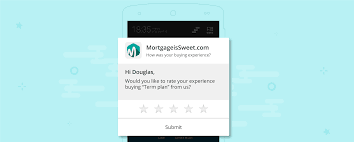
- According to one research by Izooto, an estimated 67% of customer churn can be prevented by dealing with any issues a customer has right when it happens and the best way to do that would be by sending a push notification.
10. Food Delivery Status
Right after the user has confirmed a food delivery order, keep them plugged in with the delivery status. These are one of the most effective types of push notification. Send multiple push notifications letting them know that their food is now prepared and off to their home!
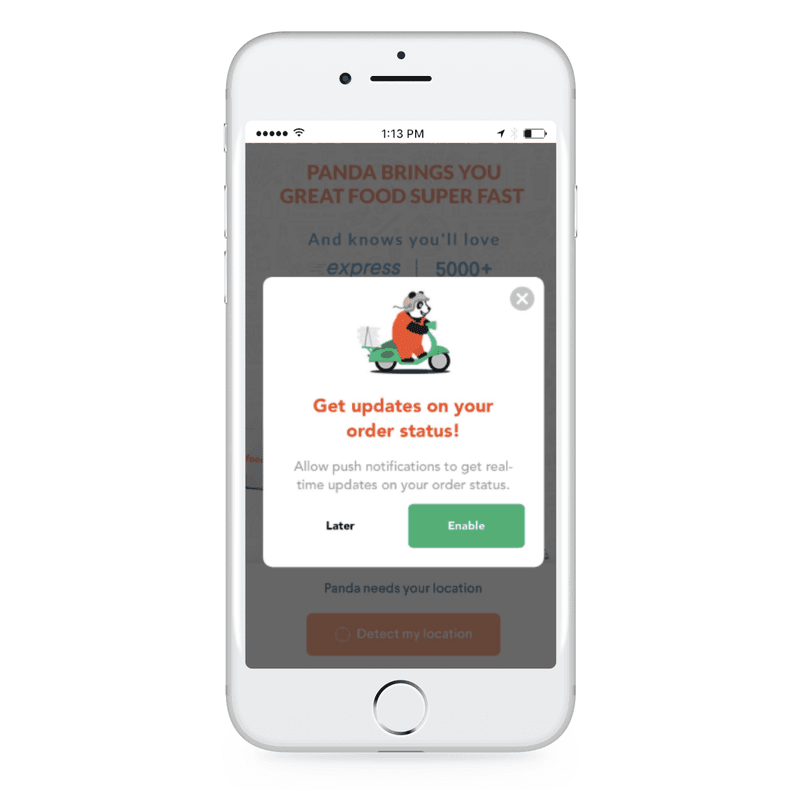
11. Share Relevant Articles
Let the users catch up with your brand by sending them push notifications reminding them to read your published articles and blogs on relevant topics.
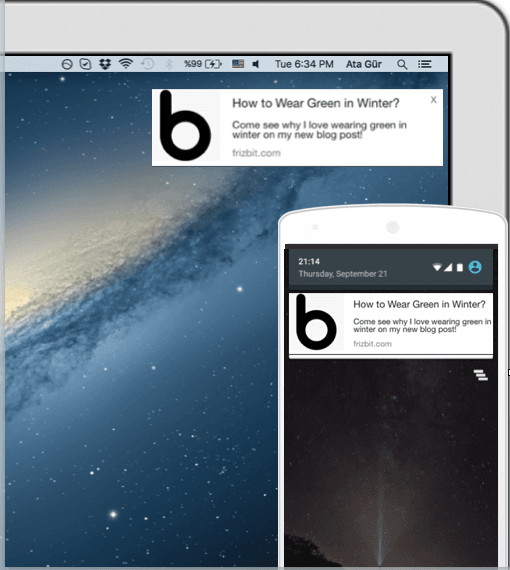
12. Broadcasts Alert
Dispatch push notifications alerting the users whenever you’re going live or broadcasting a segment. Make the users feel like they’re a part of your community.

13. Breaking News Based On Location
You can send push notifications sharing any breaking news in the geographical location of the user.
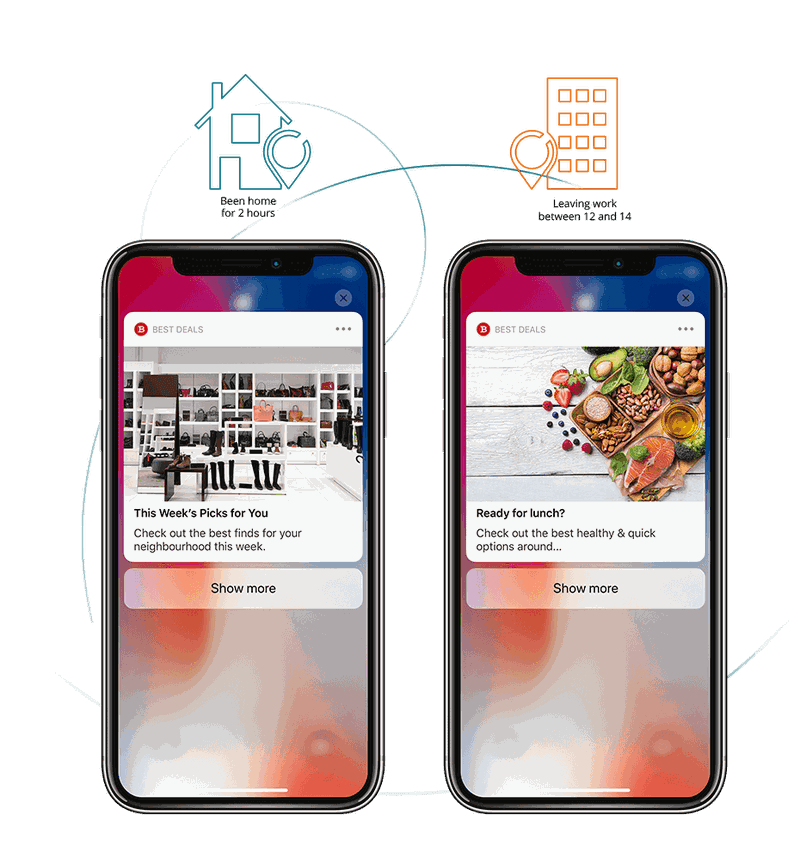
14 .Ticket Sales Update
Let the users stay updated with your brand programs and events. Inform them whenever the tickets are up for sale, especially if you’re an airline or a transport company.
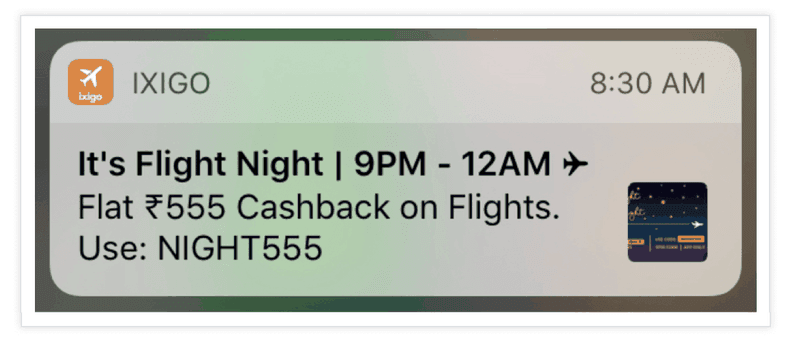
15. Soundtrack based on Weather
Music apps or websites can kick it up a notch by suggesting their audience soundtracks based on the weather through push notifications. Be it a rainy day or a bright and sunny one, there are always special tracks for your special users. These push notifications can look something like this:
“ What better time to listen to ___ than when it's raining”.
“ Start out this gorgeous sunny day with our curated playlists”.
16. Membership Expiry Alert
Use push notifications to remind the users about their membership expiry dates. You can also give them the option to renew the deal instantly.
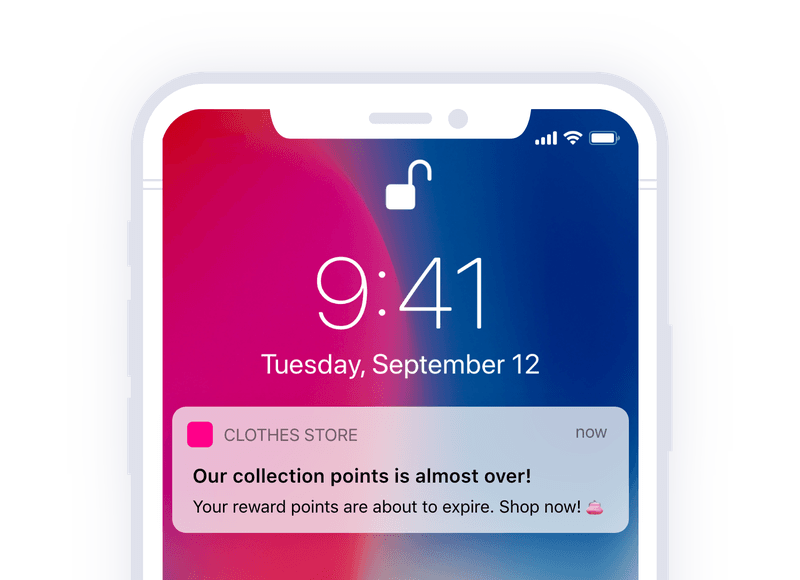
17. Commemorate National Day Or Month
Thanksgiving or Labor Day, don’t forget to commemorate the national days and months. You could also send special offers or show your curated collection on the eve of a particular occasion.
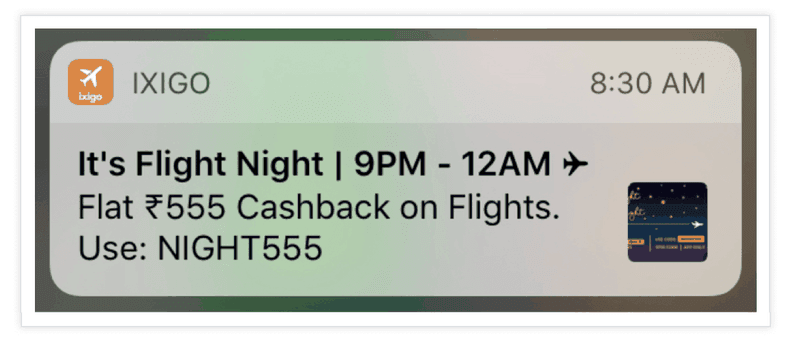
18. Friend Or Co-Worker Activity
Getting to know the activities of friends on a particular site or app instills a feeling of trust, and can be a great way of spreading word of mouth.
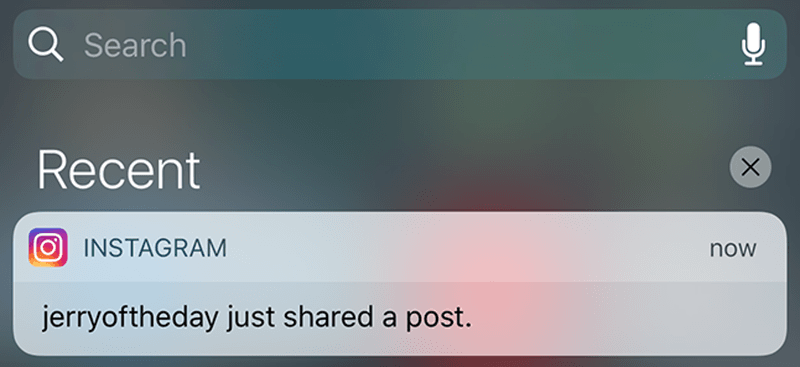
Use push notifications to trigger this reaction since according to the research of HubSpot, 81% of consumers trust the advice of family and friends while making a purchase.
19. Introduce New Features
If a user still has not tried a feature a few days or weeks after installation, send a push notification to remind them and guide them on how to use it.
“Have you checked our new feature? Now you don’t even have to put your address every time you make a purchase”.
20. Review Campaign
The users feel valued by the company when asked for reviews since it implies that their opinion is valued. A review campaign helps you engage your users and find issues to resolve.
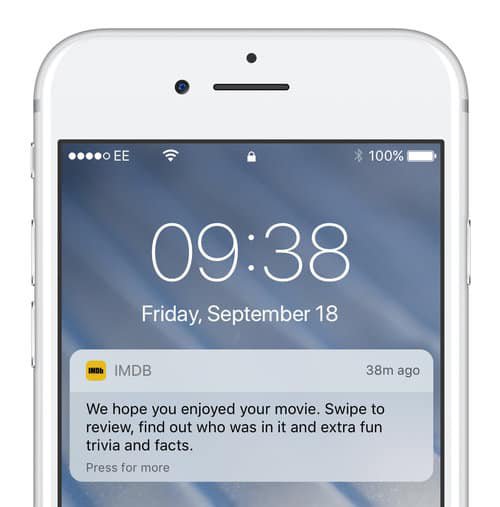
21. Keep Users In The Loop
Let the users know the latest updates about your brand using push notification templates.
Whenever you publish a new piece of content, get readers on your website within minutes of publication by notifying them about it:
“ Hey! Check out our brand new article on global warming”
You can also keep your users informed while they’re making an online transaction. Inform them of the approximate time within which they might expect the delivery or whenever there’s any delay in the delivery.
22. E-books
E-books can play a pivotal role to build credibility for your brand. Instead of waiting for users to discover your content, it’s easier if you serve it right to their devices through push notifications.
23. Announcement Of Re-Stocked Products
Keep the users updated with re-stock announcements. Push notifications informing the users about the return of a previous product can definitely up your game.
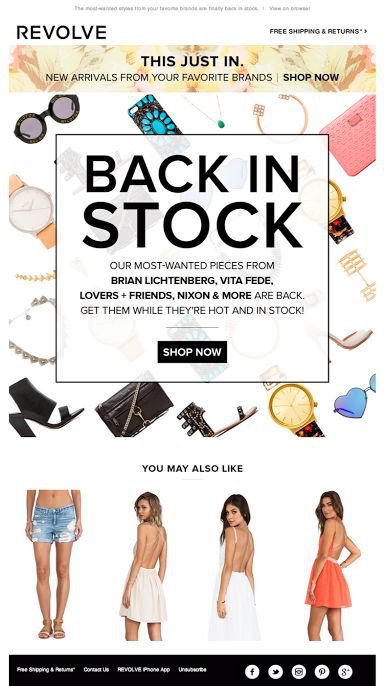
24. Showcasing User Reviews
According to a blog by Invespcro, customers are likely to spend 31% more on a business with “excellent” reviews.
Show reviews on the products the users added to their cart through push notifications. Make sure to keep a couple of things in mind while sending reviews as push notifications:
- Send positive reviews that can help you build trust with users.
- Showcase your highest-reviewed products to establish credibility.
“Hey! Have you checked The reviews of the auto open and close umbrella that you wanted to buy? Click here.”
25. Flag potential Security Issues
Make the users feel secure about your site or app. Whenever they make an irregular activity or log in from a different device, ask them “Was this you?” mentioning the details upon clicking the push notification.
26. Display Trending Products
Showcase your top-selling products or widely read blogs sending push notifications to the users. This is also a massive opportunity for inducing FOMO in the users. Use these push notification templates to drive users to make a purchase.
Did you check out our brand new ___ that everyone’s talking about?
or,
You’re missing out on ______.
27. Stock Clearance Sale Updates
While running a clearance sale campaign at the end of a season of festival, boost the program by sending a push notification to the users updating them about it.

28 Limited Time Offers
Rewards rarely fail if you want to attract the attention of your user, especially if they have a short expiry period. Send push notifications informing the users of your short-term exclusive offers:
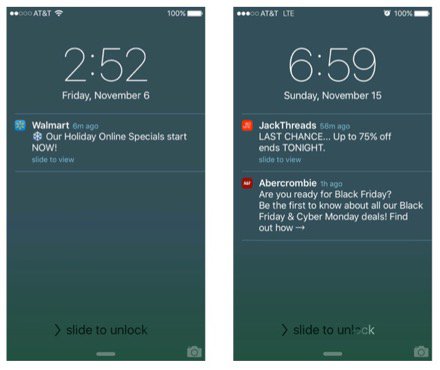
As stated in a marketing blog of MarketingMag, a recent study of Canadian millennials noted that 68% had made an impulse purchase because of FOMO triggered by witnessing someone else’s experience.
29. Holiday Offers
As per the claim of Statista, holiday shopping e-commerce was projected to increase by 35.8% by the next couple of years. Notify the users with push notifications about exclusive holiday offers, which can save them a few bucks during their holiday spending sprees.
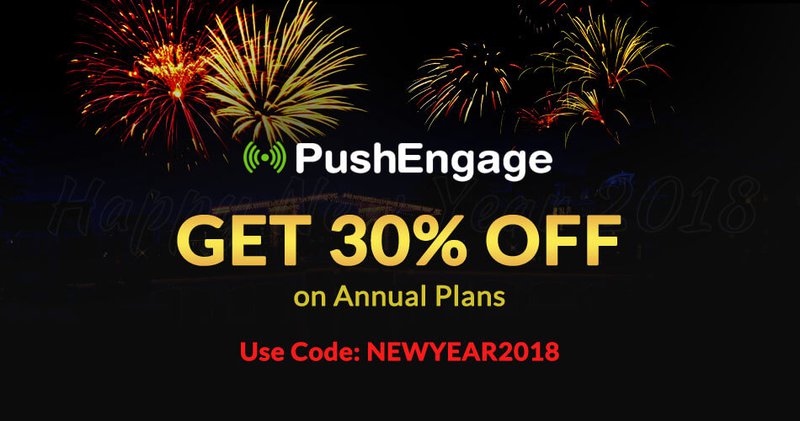
30. Vouchers
Use push notifications to sending vouchers to your users. You can also personalize a coupon using their own name. This can work wonders to instill a sense of familiarity within them.
For instance, one of the push notification templates can be something like, Mark can receive a coupon 'MARK20' which will provide him with a 20% discount on his first purchase.
31. Cart Abandonment Campaign
According to a blog of 99Firms, 4.6 trillion US dollars in retail value is lost per year in abandoned shopping carts. Give the users a quick reminder about their abandoned carts by sending them push notifications. Recovering abandoned carts can help you boost your revenue with very little effort.
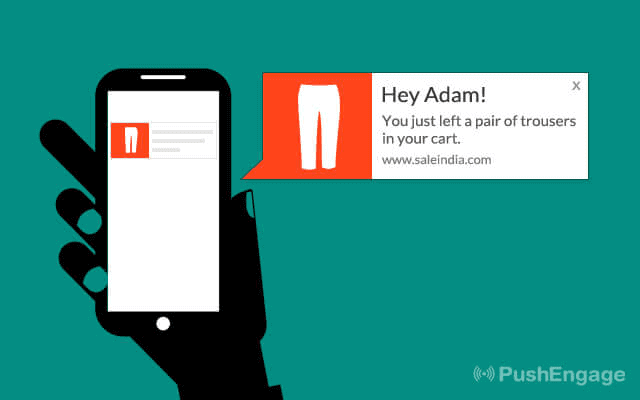
32. Personalized messages
According to a Marketing Survey in 2014, 94% of marketing professionals in multiple industries opined that personalization was “important,” “very important,” or “extremely important” for meeting their marketing goals.
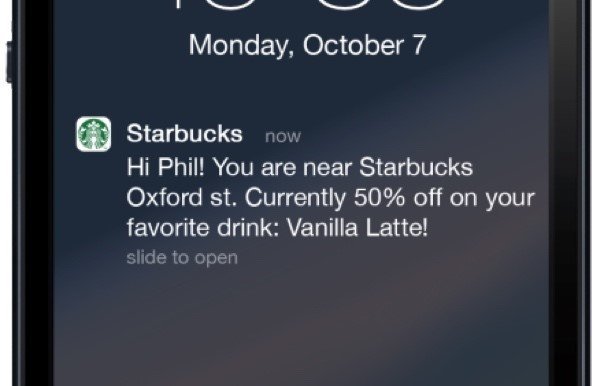
Again, according to Appcues, if 1.5% of users open a push notification, 5.9% of them love to open personalized content.
Sending personalized messages through push notifications can make a big difference, as users
33. Generating A Perception Of Achievement
Everyone loves the feeling of winning. Why not trigger it with your push notifications?
Get your user hooked by sending them push notifications congratulating them for receiving reward points, cash backs, vouchers, eBooks, etc.
“Congratulations on your new voucher by which you’ll get 20% of on your next purchase!!”
34. Flash Sale Campaign
Flash sales entice online shoppers to impulse buy, increase brand awareness and customer loyalty. These are usually time-bound and customers need to act fast to utilize the offer.
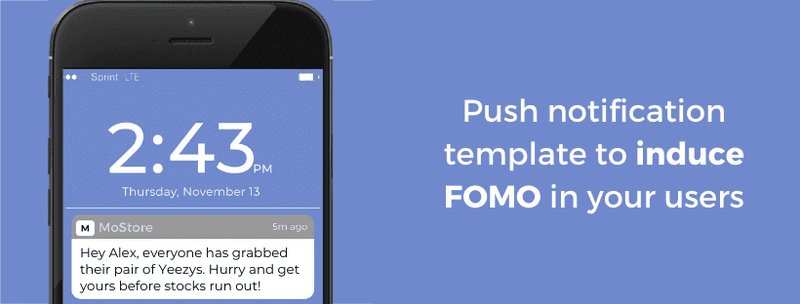
While promoting flash sales don’t forget to dispatch push notifications 48 hours before it begins. This creates an urgency to create enough FOMO while also avoiding giving the users a sense of rushed purchase.
35. Exit-Intent Campaigns
Use the moment the users are about to leave the site as the last attempt to persuade them with a push notification. As per an e-commerce statistic of Sleeknote, it converts between 2-4 percent of abandoning visitors.
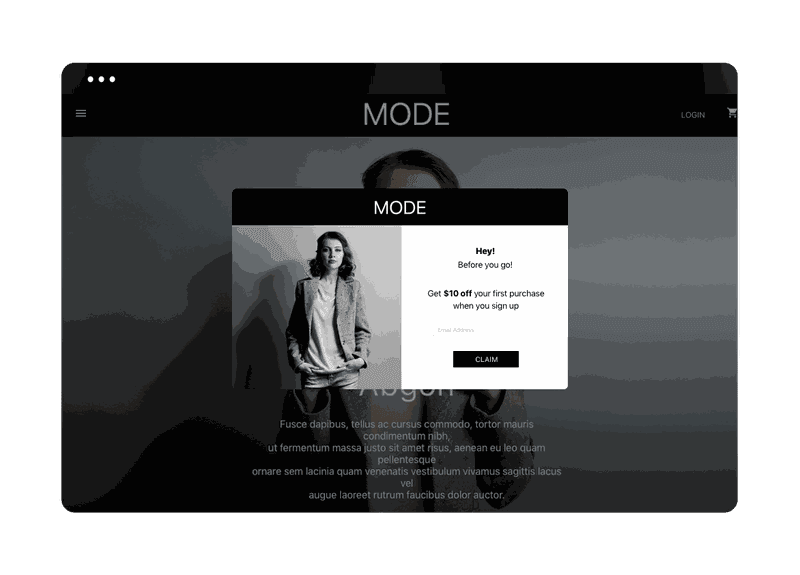
36. Free Shipping Campaign
In a study of U.S. shoppers over the age of 18, it was observed that high shipping costs are the primary reason for cart abandonment for online sales. So giving out free deliveries to the customers once in a while and sending them a push notification offering these will definitely lure them to make purchases.

37. Informing players of live events in-game
An increasing number of mobile games are featuring gameplay in real-time. You can use the perfectly timed delivery of push notifications to send real-time game updates to users.
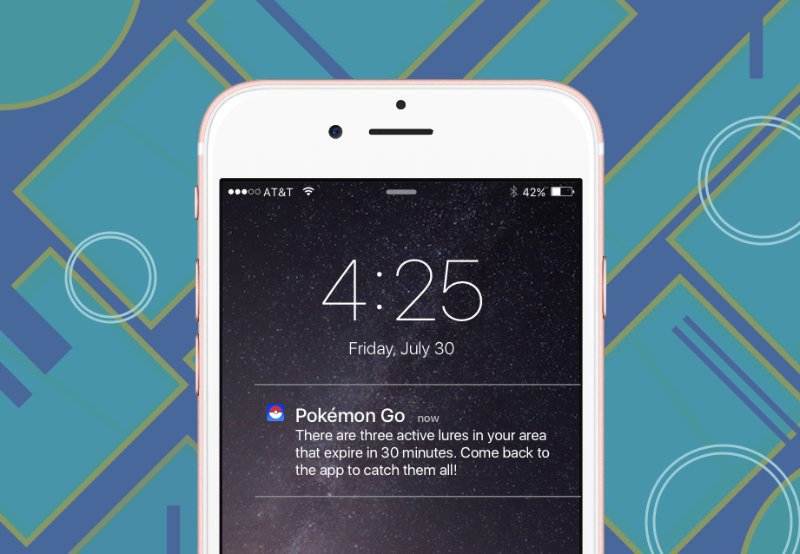
For instance, teaming up to raid gyms in Pokémon Go, or gathering to go on a game-wide hunt in MMORPGs. Make sure players don’t miss out by sending them push notifications in real-time.
38. Order Updates:
Send an order confirmation notification right after the user places it. Mention the invoice number, mode of payment, product name and quantity, and expected date of delivery.
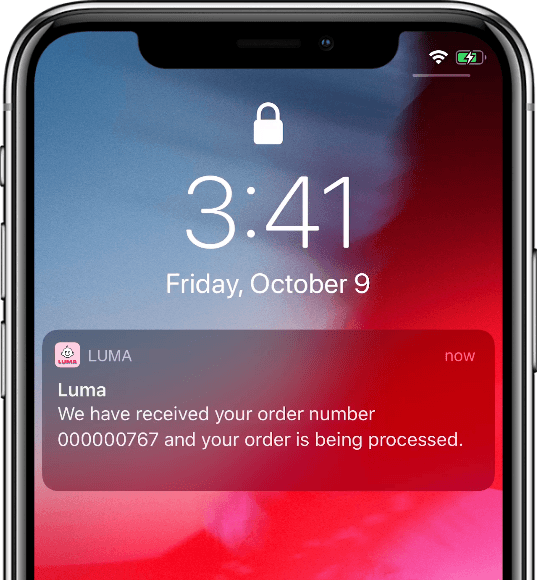
When a purchase has shipped, let customers know by sending a push notification. For instance, Amazon spiced up an otherwise bland shipping notice by writing customized copies for popular items.
If a user cancels an order, acknowledge it by notifying them about it and ask them the reason behind it as well.
39. Apologies
Stay humble and earnest by apologizing to the users for any sort of irregularities in your services. You could design it somewhat like the following push notification template:
“We’re sorry [we ran out of the product/ your flight was delayed/ the app crashed, etc.] Here’s an offer....”
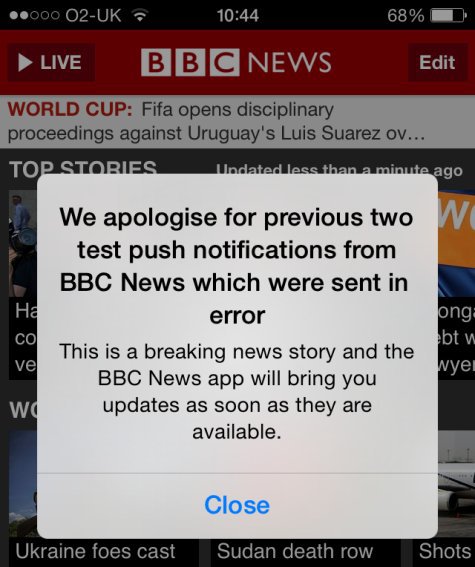
Adding a discount after expressing your apologies, makes it feel more sincere, and shows that this isn’t a common occurrence in your service.
40. Surprise gifts
Inciting suspense compels users to click on the notification and browse your site or app to learn more about it. Hence, sending surprise gifts and packages through push notifications is always an ingenious idea.
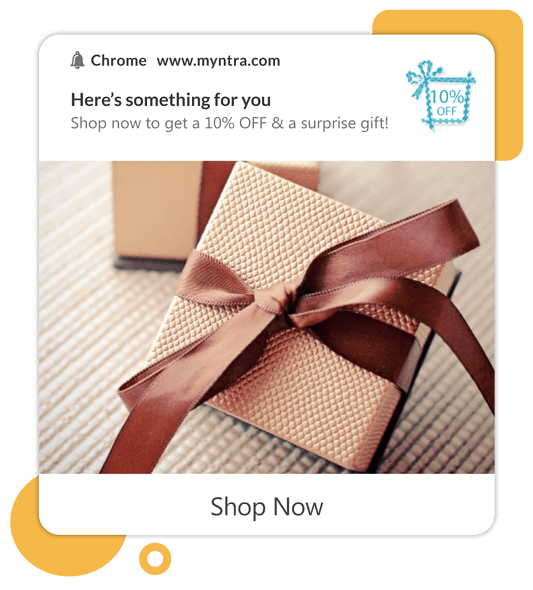
Final Thoughts
If you’re looking to kickstart your push notification campaign and having a hard time finding ideas, our list can serve as a hub of inspiration for you. You can pick from this collection of 40 of the most effective push notification templates and get your push notifications campaign up and running.
If you’re still confused, you can always leave Monsy to do the outreach work. Monsy captures your audience across multiple platforms and drives your revenue. With our top-performing ad formats, you can grow your revenue by as much as 85%!
So, what are you waiting for? Register now!
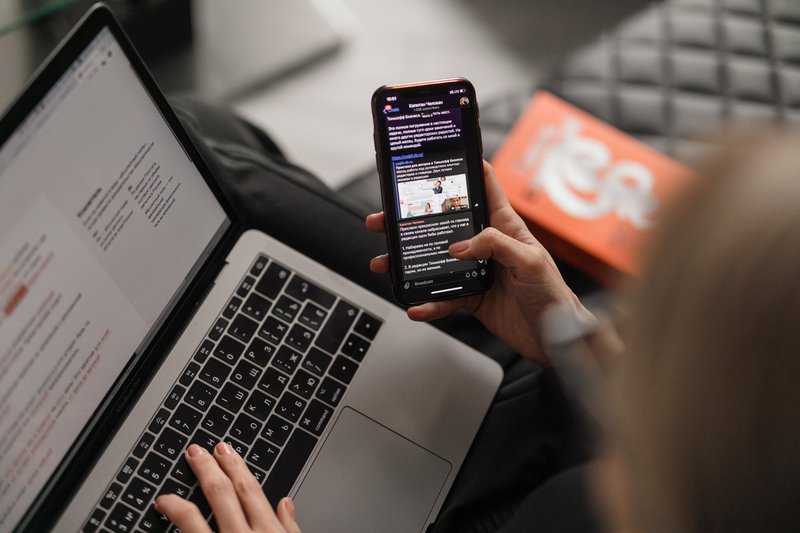
Push notifications are messages sent by a website or an app to the users’ devices to send alerts in real-time. These can be personalized to drive desired actions from customers. Customers who opt-in to receive push notifications only need to be online to receive push notifications, even if they are not using the browser/app at the moment.
What Is A Push Notification And How Does It Work
Push notifications, also known as rich messages, or actionable messages, are messages that pop up on your mobile phone or desktop from various applications or websites. Clicking on these messages will redirect you to that particular app or website. You don’t even need to have the app or website opened to receive their notifications.
With email open rates in decline, push notifications provide a perfect alternative to communicate with your users.
Push notifications are also more user-friendly than text messages. Many users perceive promotional text messages as spam, making them likely to opt-out of receiving them.
How Do Push Notifications Work?
Web Push Notifications
Push messages for websites help to re-engage with customers through relevant content. However, users need to opt-in on the website first to receive push notifications.
- When a user opts-in to receive push notifications, a message is sent to the GCM push service.
- The GCM service sends a request to the service worker on a web browser.
- This, in turn, helps in checking whether that user has signed up for the updates before.
- After that, the service workers keep sending push notifications to the user when relevant.
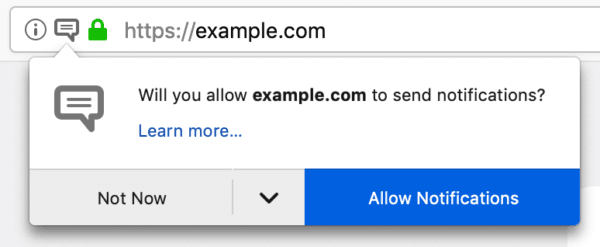
Mobile Push Notifications
- For Android: The push messages on android are sent by default.
- For iOS: The push messages on iOS are blocked by default.
There are different policies for iOS and Android regarding push messages. The likelihood of an iOS user to open a push notification is lesser than an Android user. But if they do open a push notification, they are likely to do it faster than Android users.
Most iOS apps use a pop-up to ask for permission to allow push notifications when users open the app for the first time after installation. Making the content of your push notifications actionable can drive more open rates. The median opt-in rates for push notifications are up to 70% for charity and travel apps and 33% for games.
Things To Know Before Sending Push Notifications
1. Know The User And The App
Know the preferences of your users and what they like before sending push notifications. Users have downloaded your app because they liked it. But do they like it enough to receive daily updates about the app? You need to consider the likelihood of a user opting out of receiving these updates before you start sending push notifications.
2. Figure Out The Frequency of Sending Push Notifications
The frequency of sending push notifications varies among different brands and is contingent on a number of factors. If your app sends notifications more or less of the same nature, it’s better to send them sparingly.
No one wants to be reminded of the same thing over and over again. But if your notifications are varied, innovative, and entertaining, you can send them more frequently.
There isn’t a rule of thumb when it comes to the frequency of sending push notifications. You need to figure out your optimum frequency based on your product, marketing needs, and users.
There are different acceptance thresholds for sending notifications for different types of products. For example:
- Gaming apps can send one notification a day. But, consider the timing to send the notifications in the gaming apps carefully.
- New apps can send 3-4 notifications per day. But, the notifications need to be relevant to your users.
- 3-4 push notifications per week for a fitness app is acceptable. Though, it mostly depends on that particular app.
3. Send Push Messages At The Preferred Time
Timing is one of the major aspects while sending push notifications. You need to consider a few things while scheduling your push notifications:
- Send push notifications on happy hours to get the best results.
- 10 AM to 1 PM is the prime time in any territory for sending push messages.
- Target push notifications according to the time zone of the user.
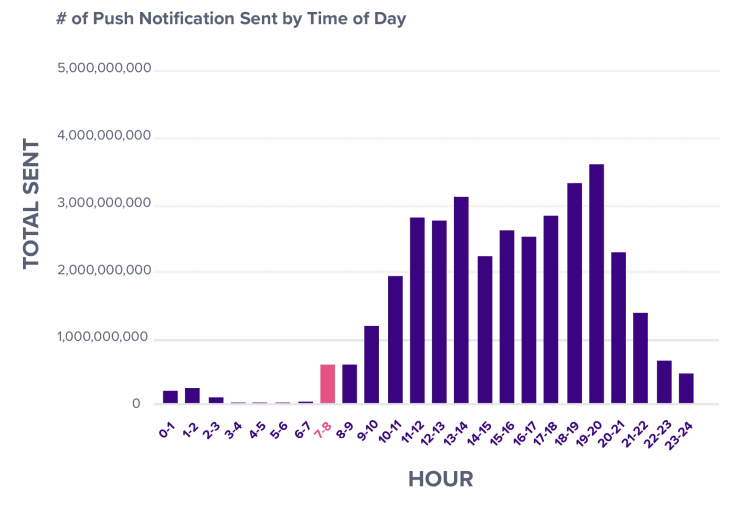
4. Send Push Messages According To The Users Location
A lot of large-scale businesses use geofencing technologies to send push messages based on the users' location. Tracking the users’ location, with their permission, will allow you to drive up sales owing to better personalization.
5. Maintain The Character Limit
Push notifications also appear on lock screens, and unlike text messages, users can’t click it and watch the entire text. Thus, push messages need to have a certain character limit.
Shorter push messages have higher click-through rates. 10 or fewer words in a push notification have a click-through rate of 8.8%. Whereas, 11-20 words elicit a click-through rate of 4.9%. The figure drops to 3.2% for 21 or greater worded push messages.
Why Are Push Notifications So Important
1. Boosts User Retention
User retention allows you to understand how well your app is performing in the market. You can figure out how many users have downloaded your app and used it more than once with the help of this metric.
According to Statista, in 2019, 25% of users downloaded an app never again to return to it, which creates no value for the businesses. Push notifications are one of the most effective ways to bring back disengaged users.
Sending push notifications also helps to increase your retention rate. If your app can send personalized notifications that create value for your users, retaining them for the long term is a cakewalk.
2. Increase Conversion Rates And Monetization
Push notifications aim to elicit an immediate reaction from the user. Making call-to-actions relevant and contextual also helps drive up your conversion rates.
In fact, well-crafted push notifications can drive conversion rates by 4 times, helping you ramp up your revenue.
Monsy lets you harness the power of push notifications to easily capture the attention of your audience across multiple platforms, and eventually skyrocketing your revenue.
3. Increases User Engagement
Along with boosting user retention, a strong push notification strategy also helps to increase user engagement. These push notifications nudge the users towards action, in case they are too busy to open the app.
- A well-crafted push notification strategy informs users about an offer they could activate within a time limit while personalizing it to their needs.
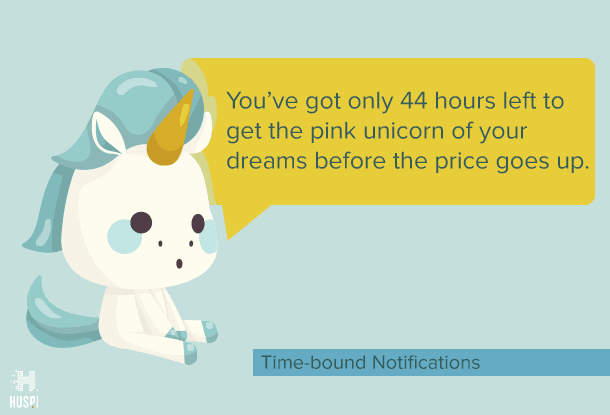
- Remind users that were close to completing an action, like an abandoned cart or signing up for a free trial.
- Send alerts to users reminding them about upcoming events, updates, offers, etc.
- Show up-to-date and relevant news to the users according to their preferences.
This helps users engage with your app or website and increase engagement. Deep linking within push notifications can help engage a user even more and eventually drive them closer to action.
4. Targets The Right Users
Once you’re allowed access to the users’ location, you will have an opportunity to capitalize on location-specific push notifications. This allows you to send offers personalized to users living in a certain territory, which can be a country, state, or city.
For example, Waze informs its users of nearby gas stations and gas prices along with traffic situations around them. Similarly, SeatGeak shows up ticket offers on their push messages of games happening around the users. Personalization doesn’t have to stop at the location of your users.
You can also utilize the data you can collect about your users’ interests and send push messages based on them. Netflix sends notifications about the release of a new season from a series that a user has already watched. While you might get notifications to watch Mean Girls, someone else will receive notifications about the new episodes of Black Mirror.
5. Grows Subscribers Quickly
The opt-in rate of notifications from websites is typically 10-15%. You can notice the results immediately after installing a push notification service.
Users are shown a small pop-up, which they can use to subscribe to notifications by simply clicking ‘Allow’.
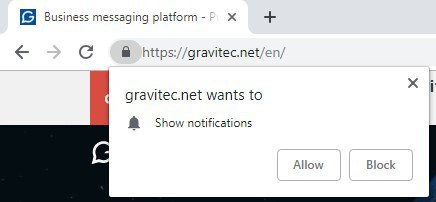
This easy opt-in process allows you to grow your subscriber base rapidly. If you consider the alternatives, such as forms, the ease of subscribing to notifications clearly stands out.
A good practice is to send your subscribers a welcome message as soon as they subscribe. This helps to solidify your connection with the subscribers even further.
6. Catches User Attention
Although a basic push notification contains a header, an image, text, and a link, there are rich push notifications that include videos, images, audio, and interactive media. Chrome, Opera, and iOS all support rich push messages.
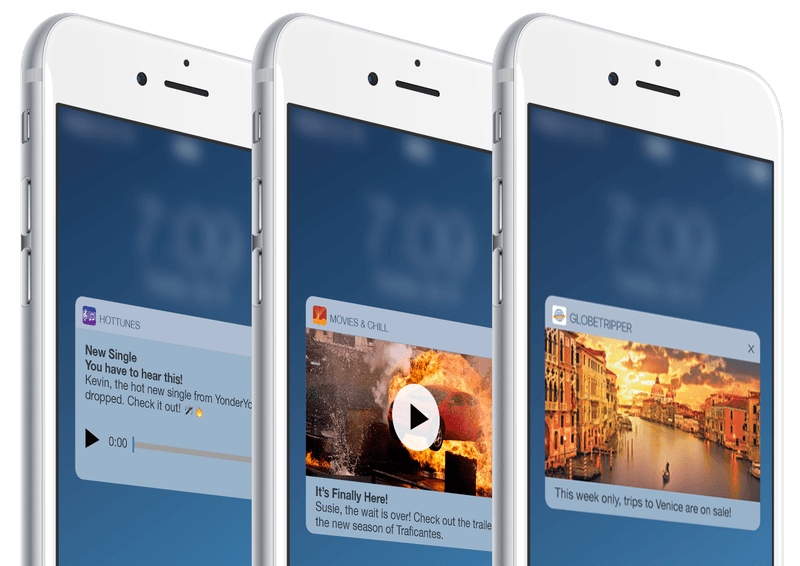
These rich push notifications drive interest from users, thanks to their interactive nature and catchy visuals. These help you to drive up user engagement, loyalty, and retention.
7. Increases Traffic
Driving traffic to your blog is no easy task. It can take a while for your content to rank higher in search results, and not every business has the budget to spend on paid search marketing. This is where push notifications prove their worth.
Sending push notifications that redirect users to new content can help you grow your traffic steadily. If done correctly, push notifications can drive up your click-through rates up to 40%.
For example, The San Francisco Chronicle had a 150% increase in traffic and The Tribune Publishing Network saw a tremendous increase of 293% in online subscriptions.
If you’re looking to gauge the impact of your push notifications, you can use Monsy to calculate the increased revenue due to the growing traffic.
8. Allows Easy Opt-in And Opt-out
Users can easily opt-in and opt-out of push notifications from your app. The ease of opting out makes sure the users receiving the updates are genuinely interested in them.
In fact, 26% of users enjoy getting updates about their preferred content and therefore, like receiving push notifications. Surprisingly, 20% of users noted that push messages help them increase their productivity.
You can analyze user feedback and activity to gather information about the optimum frequency and timing of sending push notifications. If your users opt-out after they receive 5 push messages a day, that’s your cue to re-assess your push notification strategy.
9. Enhances User Experience
Apart from being a brilliant marketing channel, push notifications can also greatly improve user experience.
Let’s consider FoodPanda for instance. You can place your order and then wait for your food to arrive. But you’ll get way too impatient and text the delivery man every two seconds. To solve this issue, FoodPanda keeps you updated on the delivery status by sending you notifications. You’ll receive a push message when the food has been prepared, another when the food man picks up your order, and then one last one when the food has arrived at your destination.
Foodpanda’s push notification strategy helps them improve user experience by creating actual value for their users.
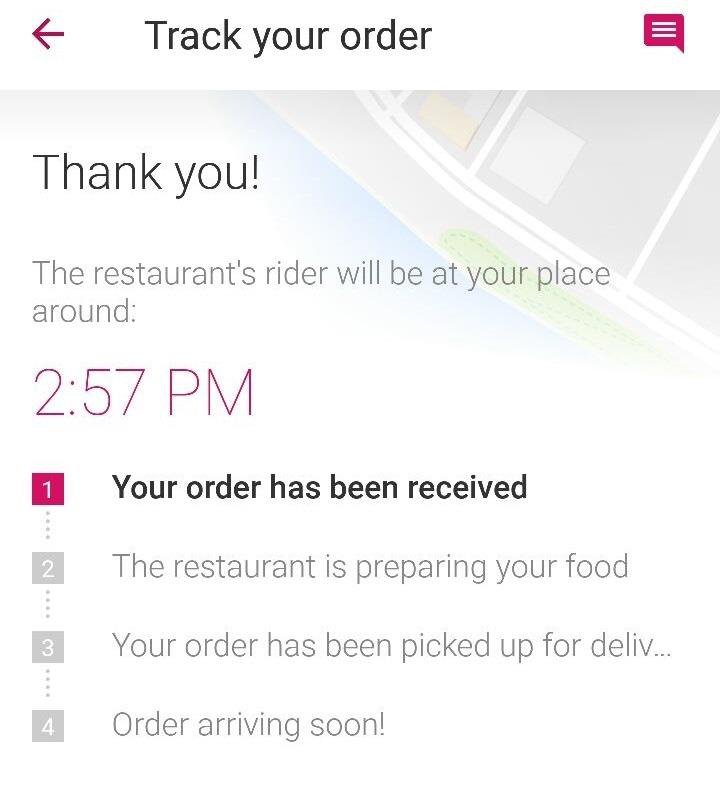
10. Allows Segmentation and Behavioral Targeting
Push notifications allow you to segment your subscribers by:
- Browsers
- Operating Systems
- Geographic locations
Once a user subscribes, the service collects and stores all the metadata from the user’s device instantly. The data collected here can be used later for segmentation and targeting.
Apart from basic segmentation, you can also use behavioral tracking to personalize push notifications. It helps you create comprehensive profiles that help personalize push notifications based on user preferences.
Behavioral segmentation helps you create a user-centric strategy instead of a product-centric one, which helps you predict the decision-making patterns of the user.
Final Words
Marketers are increasingly relying on push notifications as a point of differentiation. Push notifications are indeed a great way of standing out from your competitors and create value for your customers.
Before you dive into it, keep in mind that what worked for your competitor might not work for you. So consider your product and user preferences while crafting a push notification strategy.
So what are you waiting for? Register now on Monsy today to get your push notification campaigns up and running!